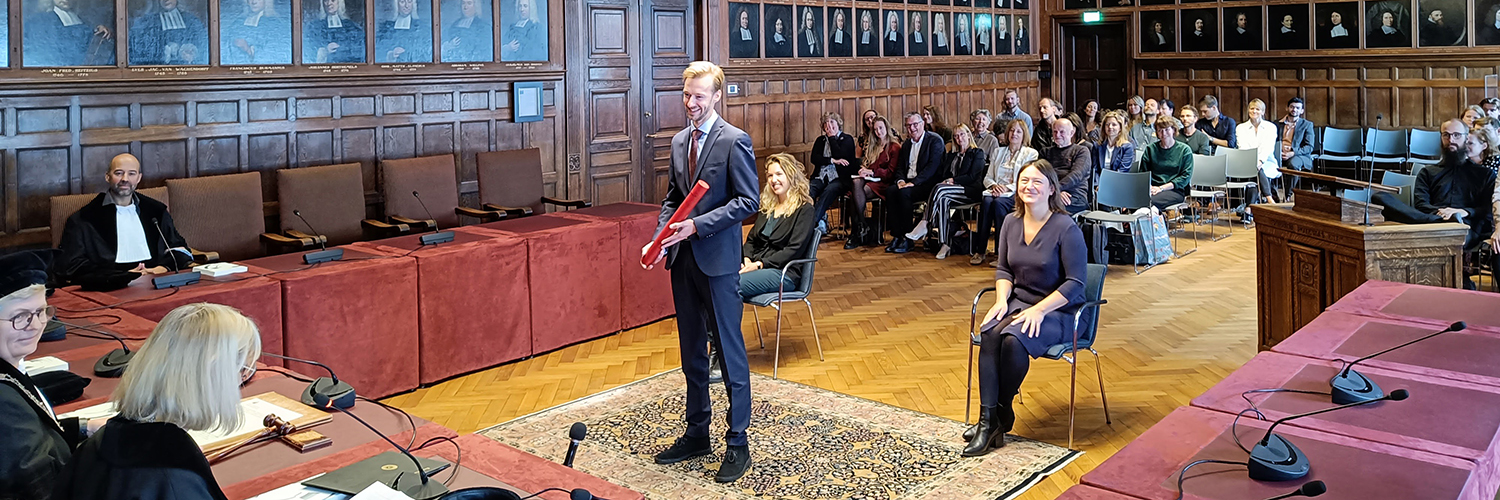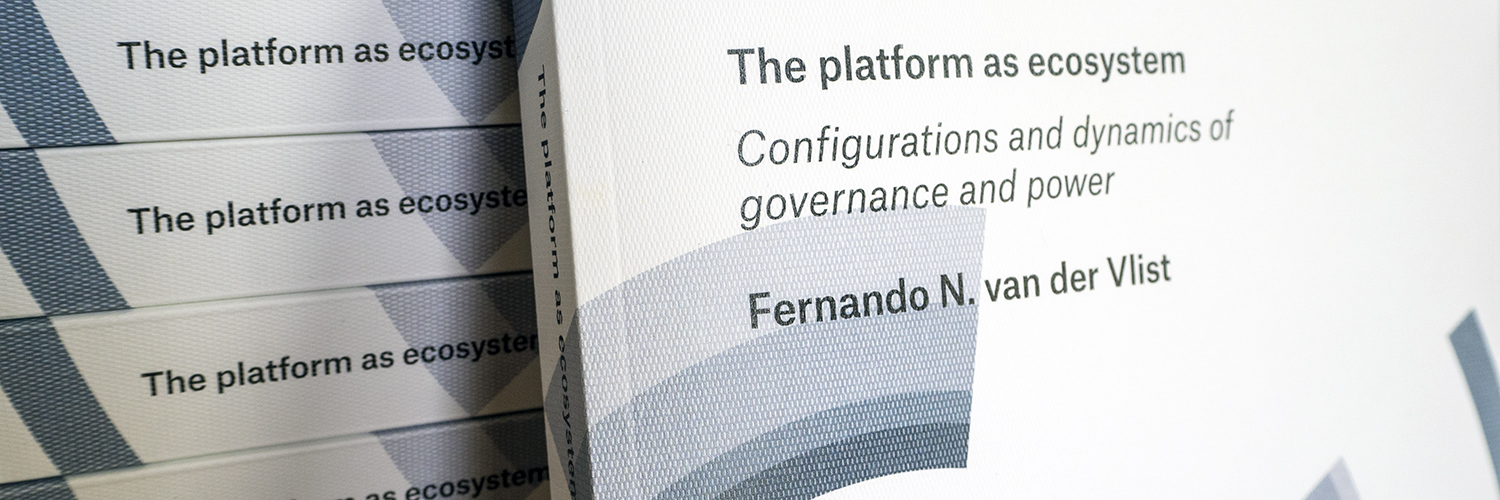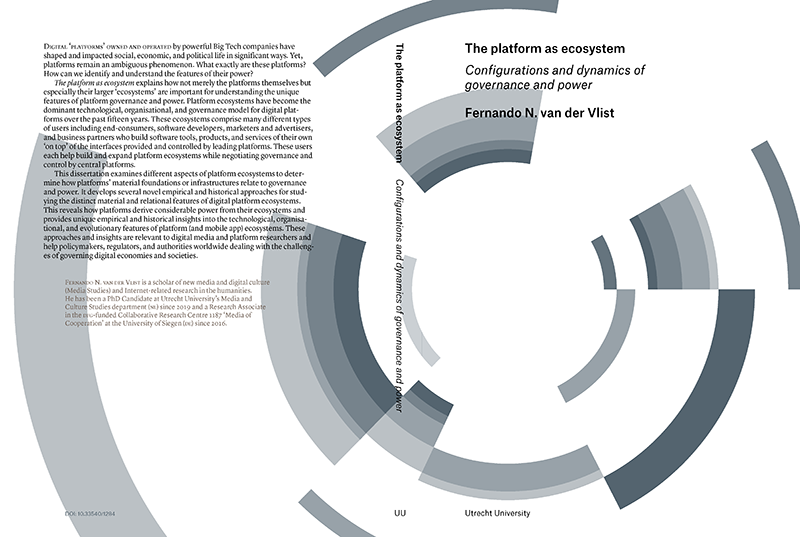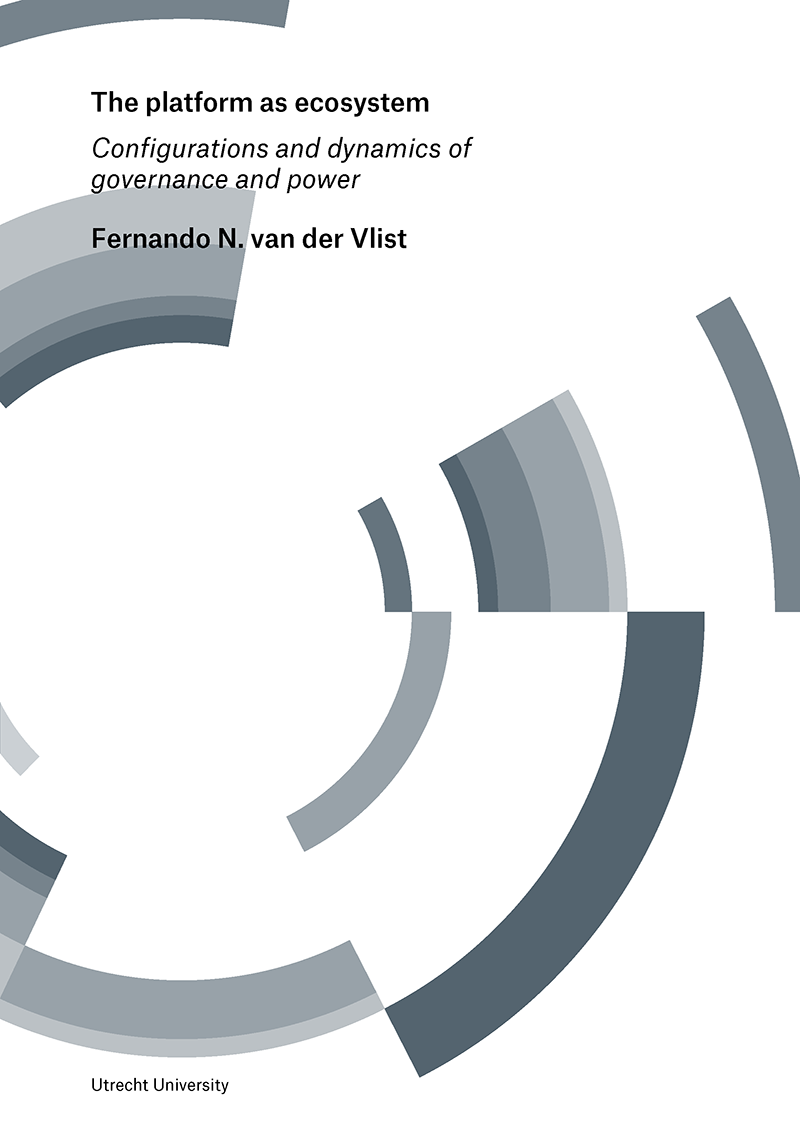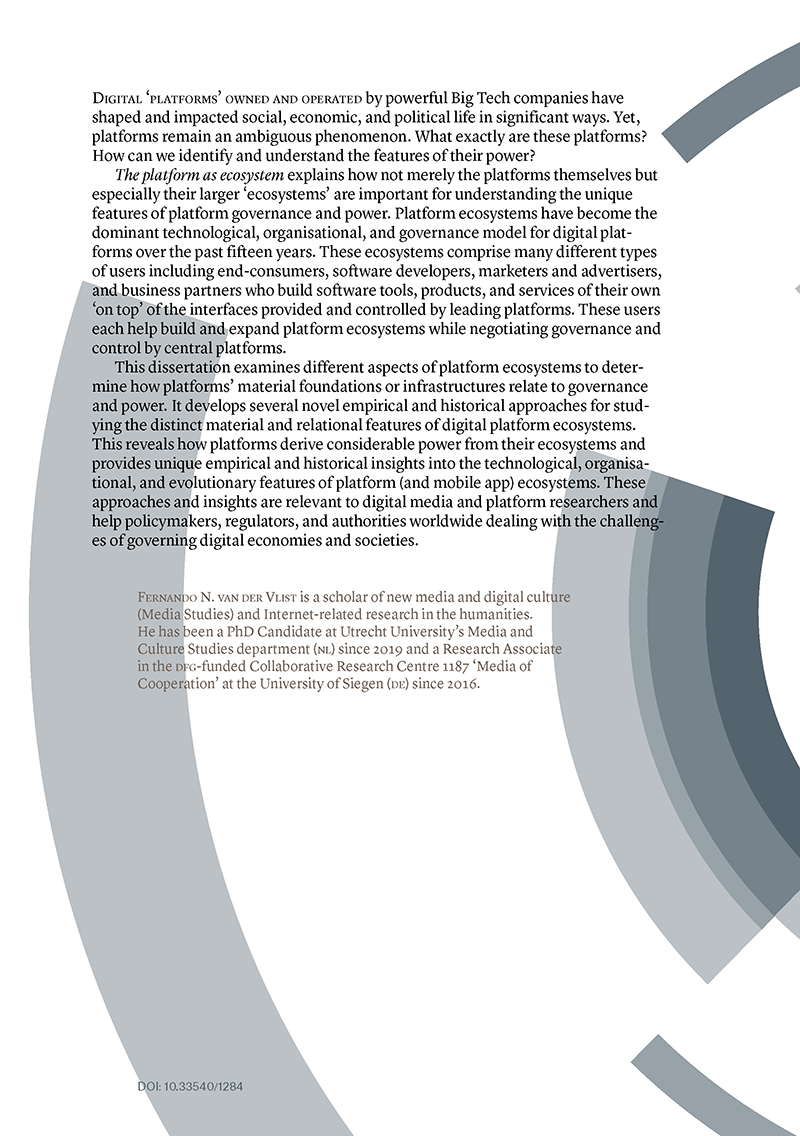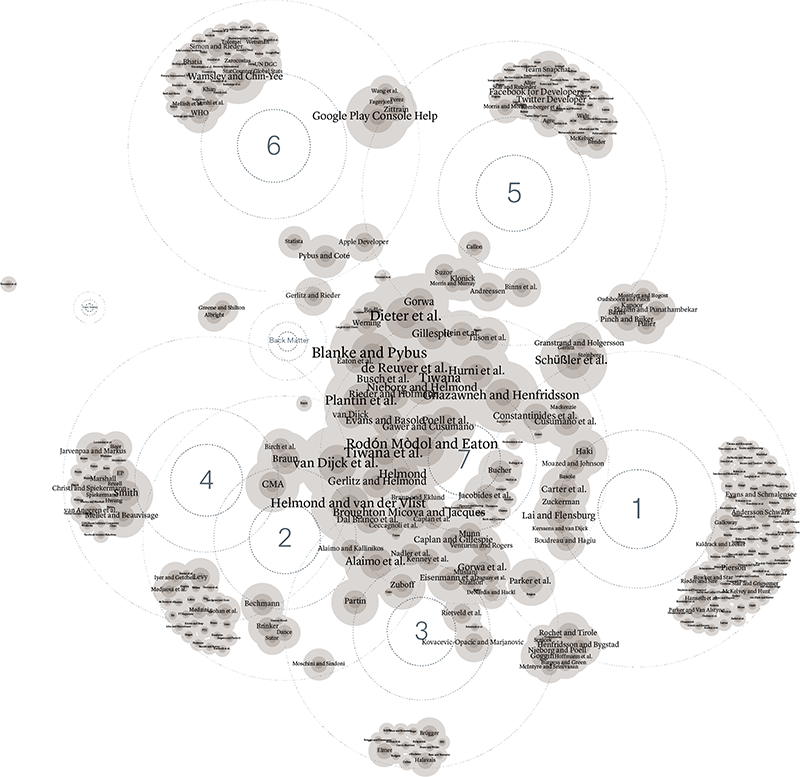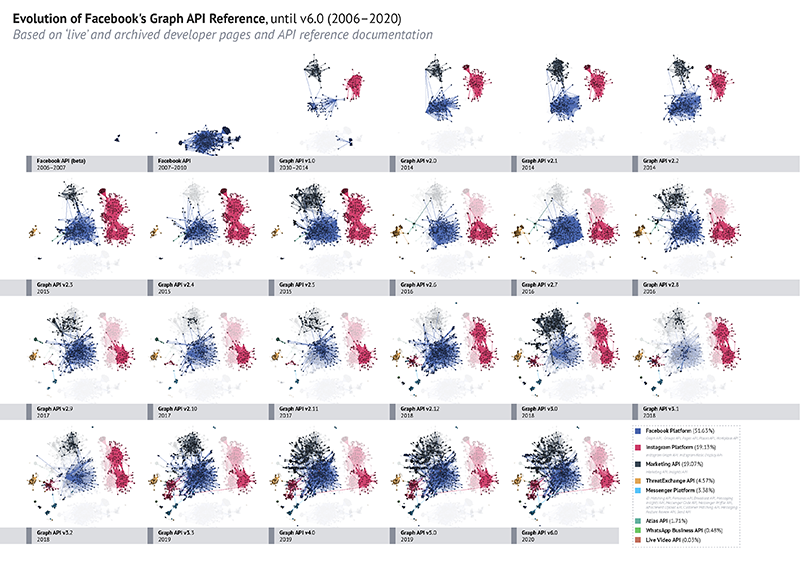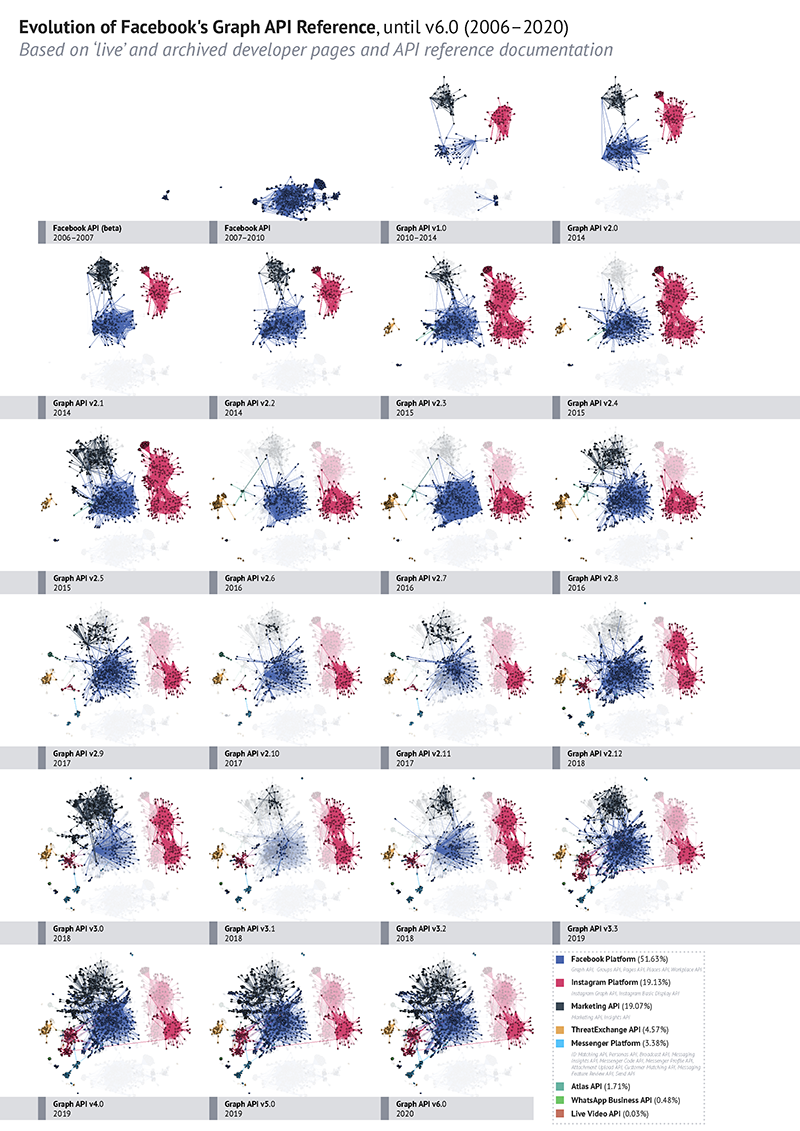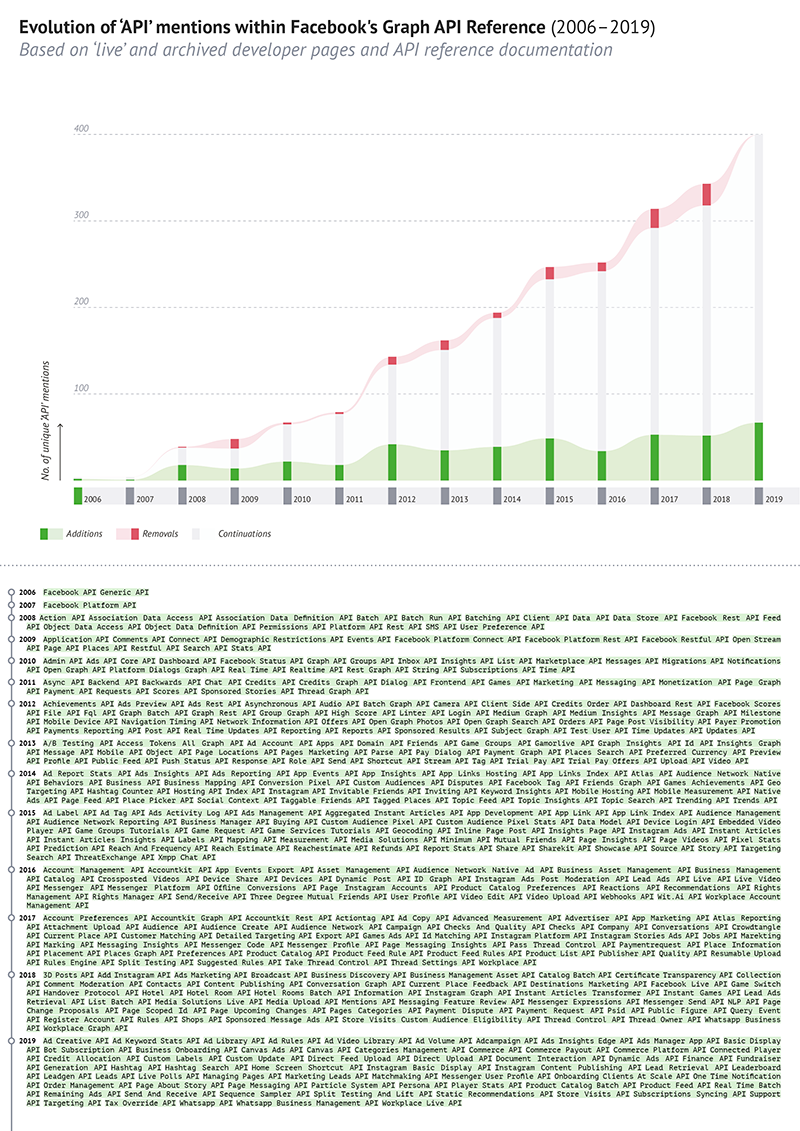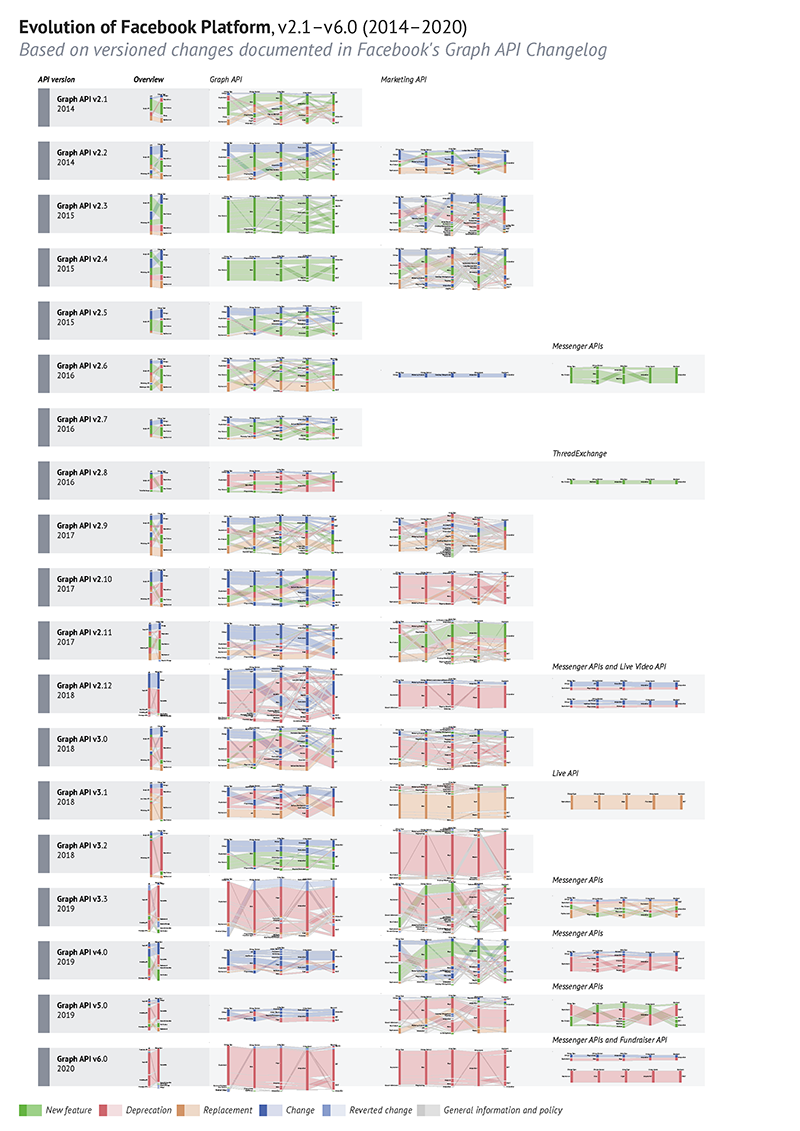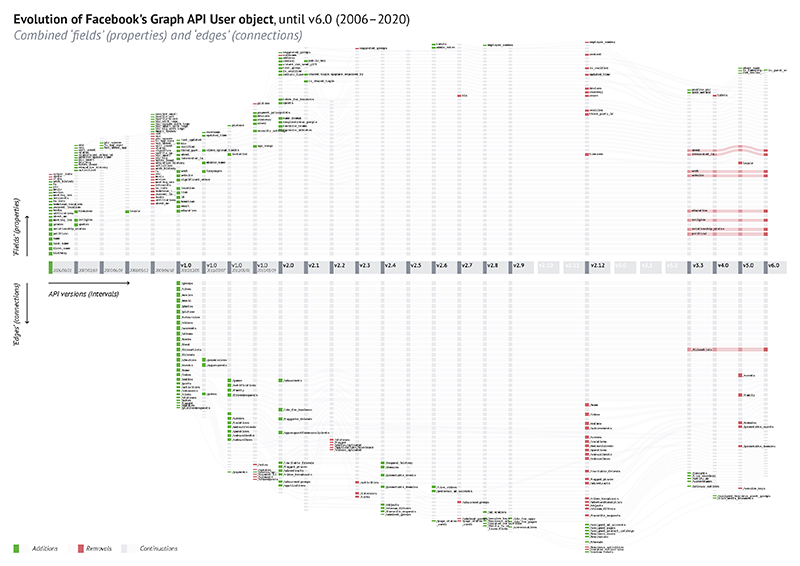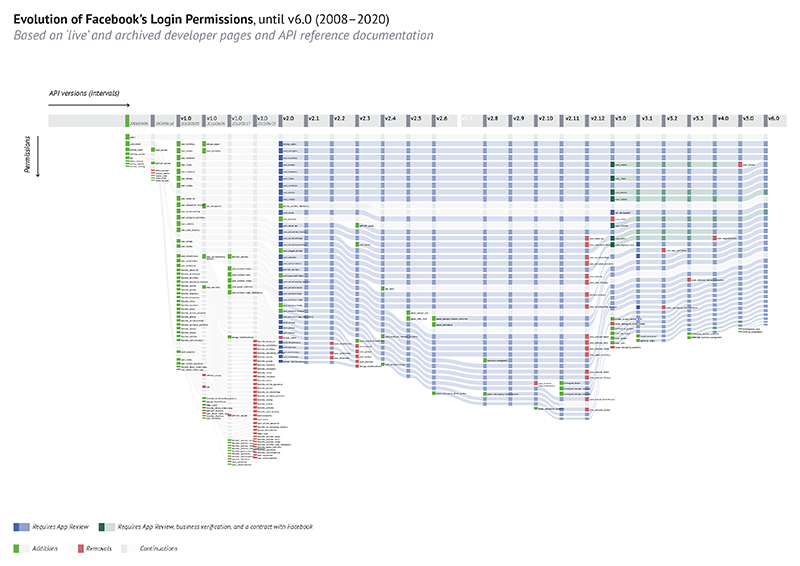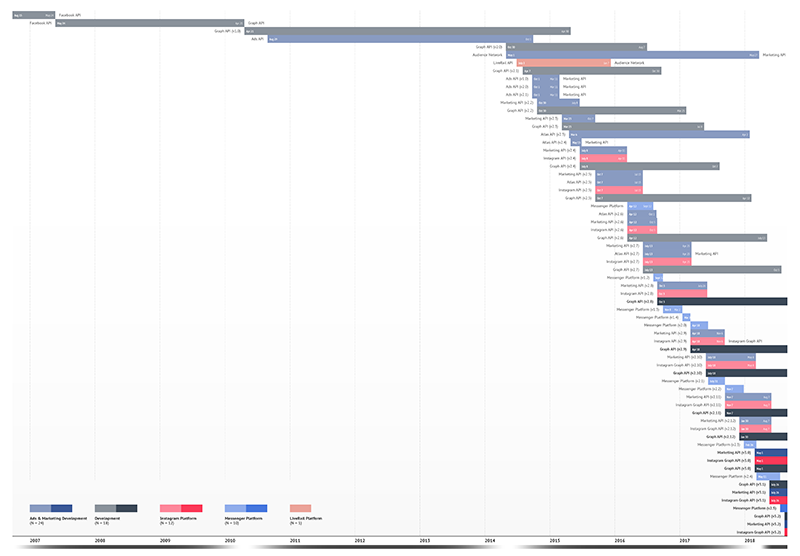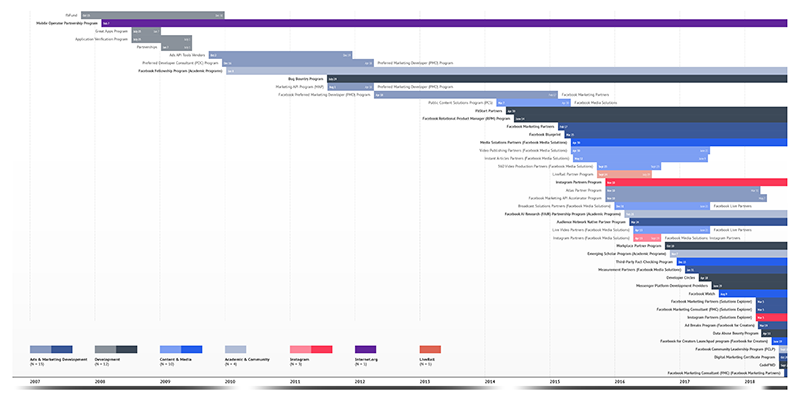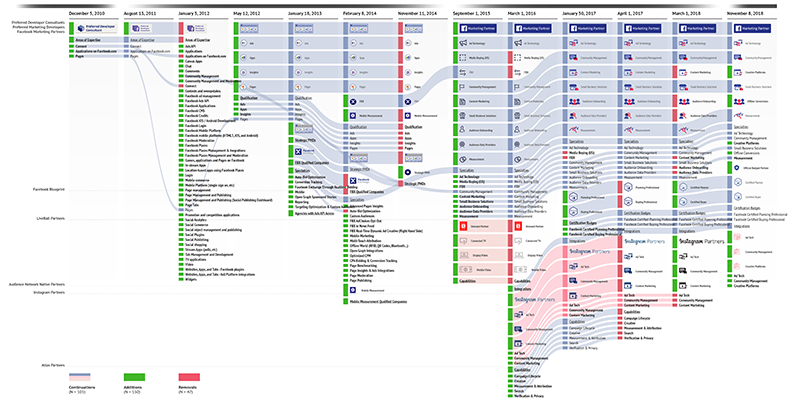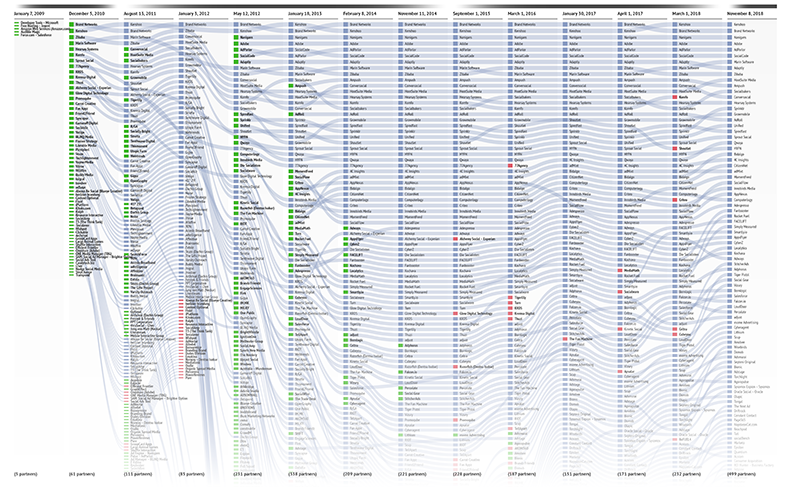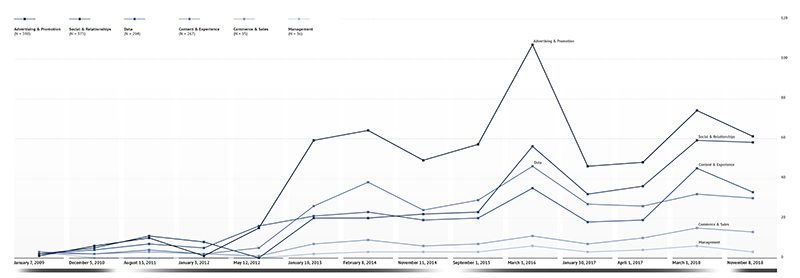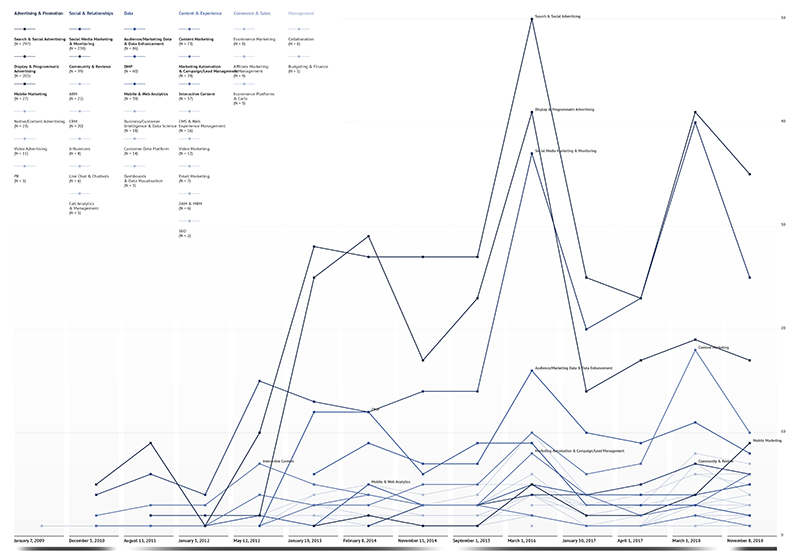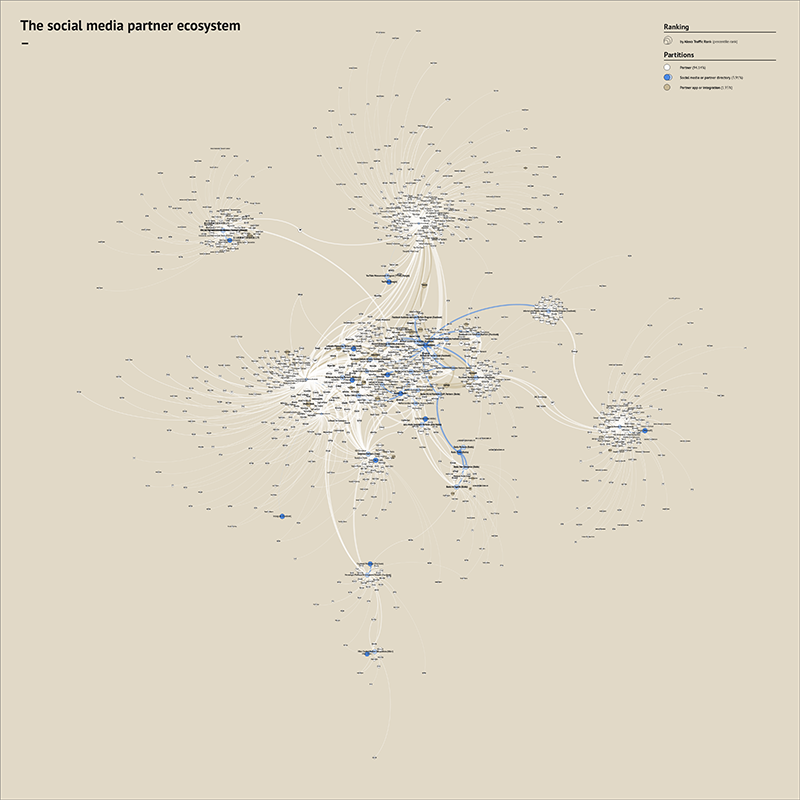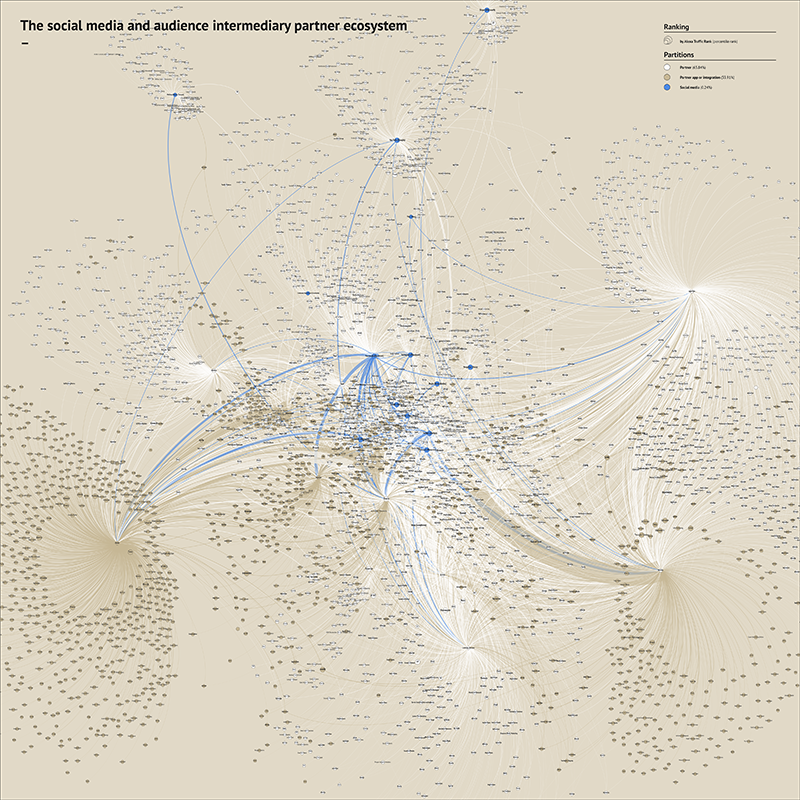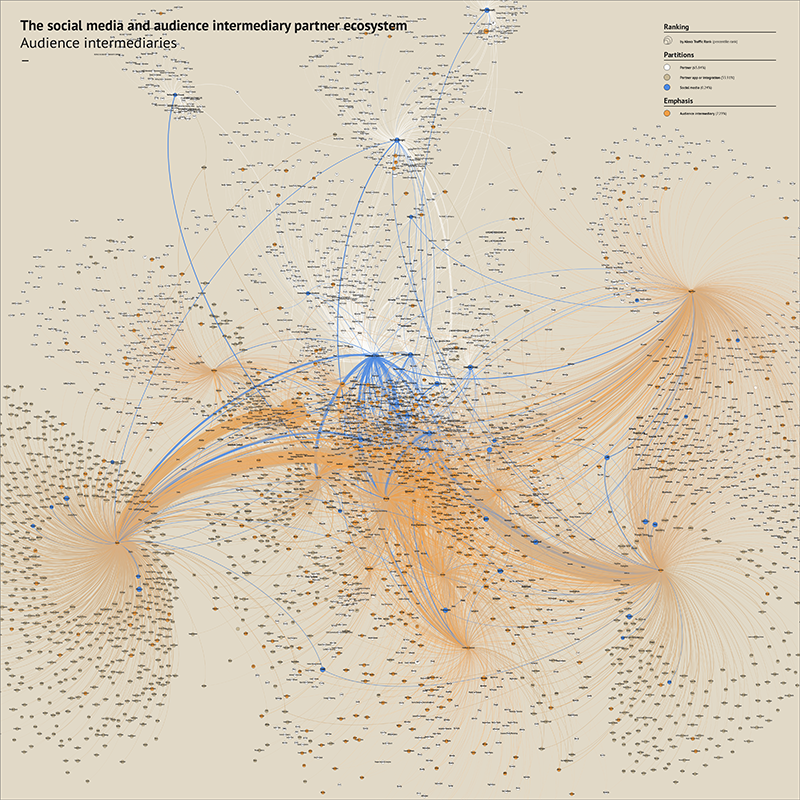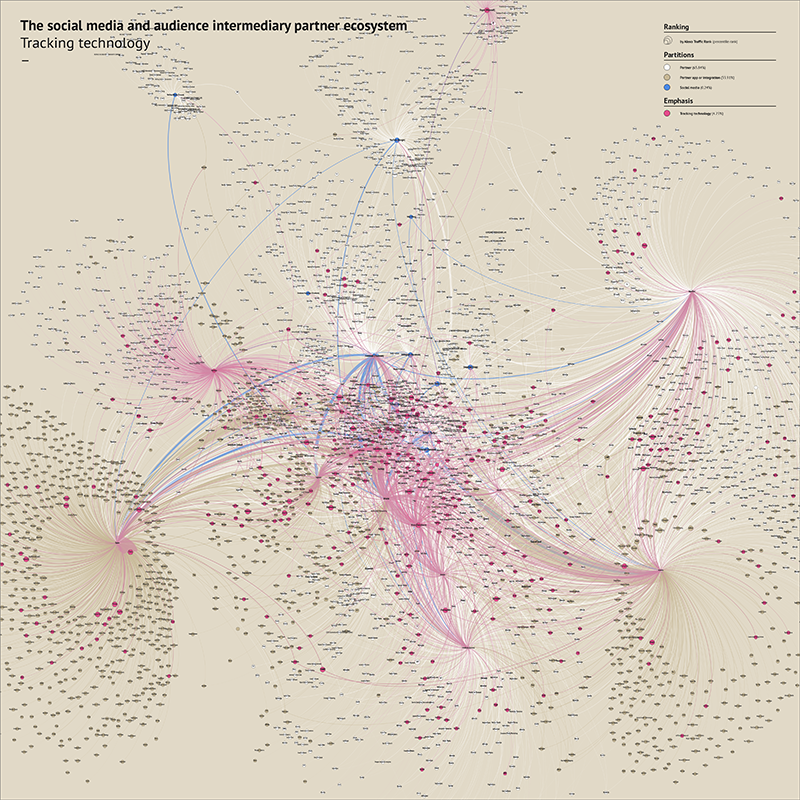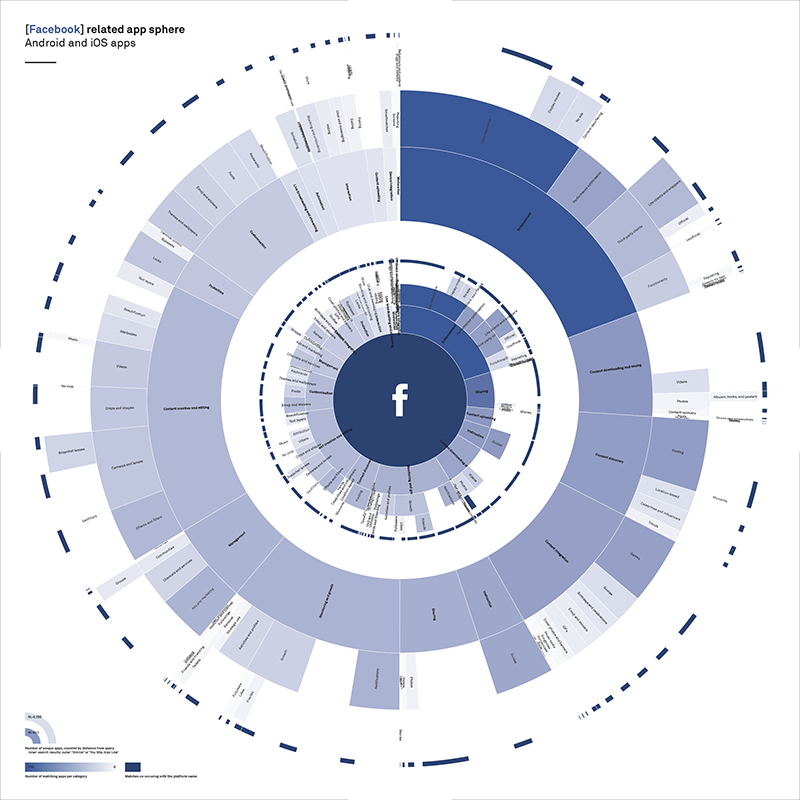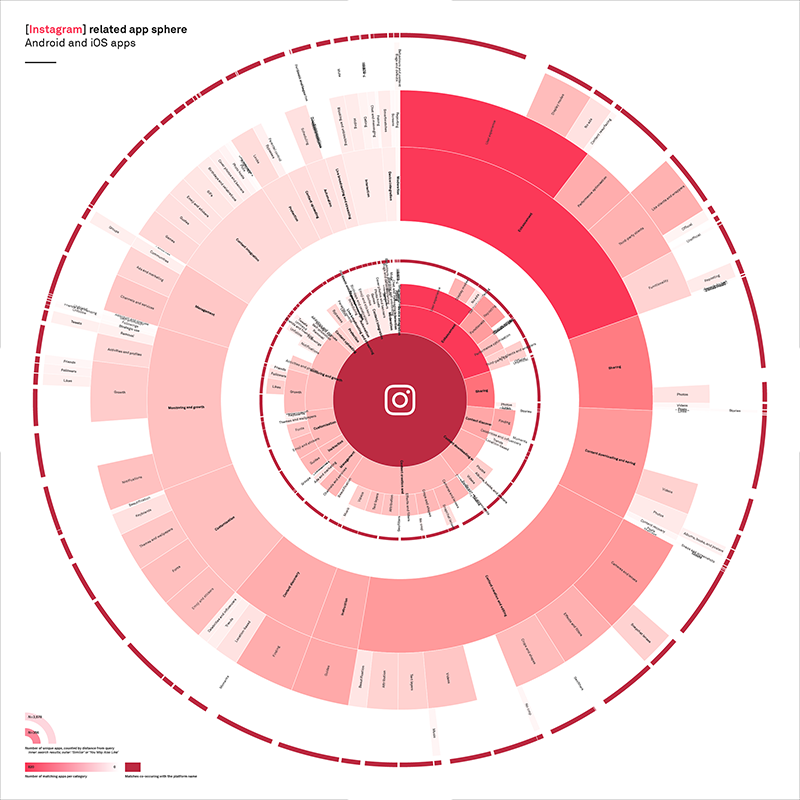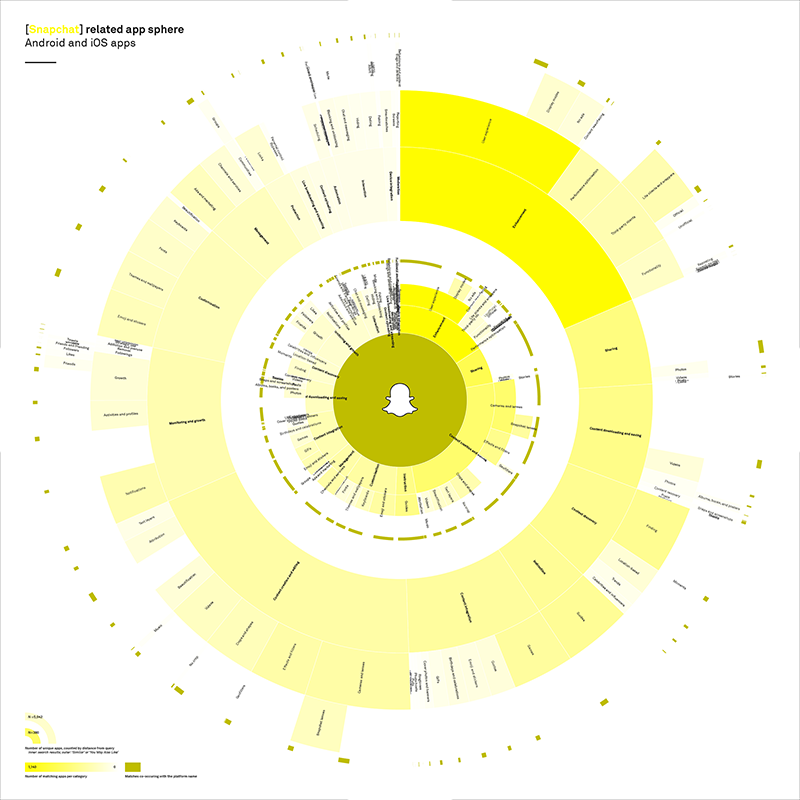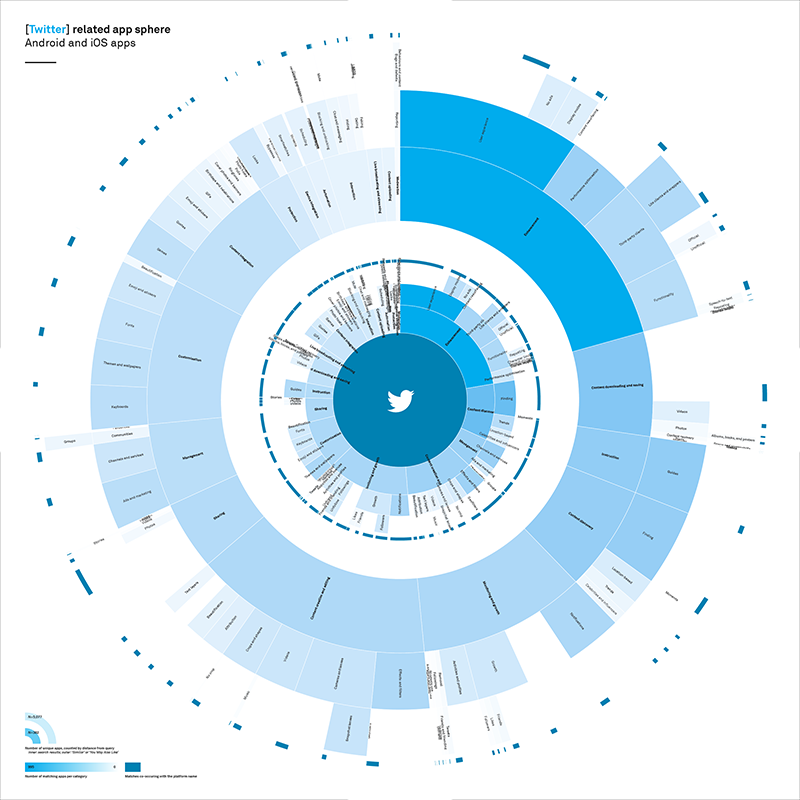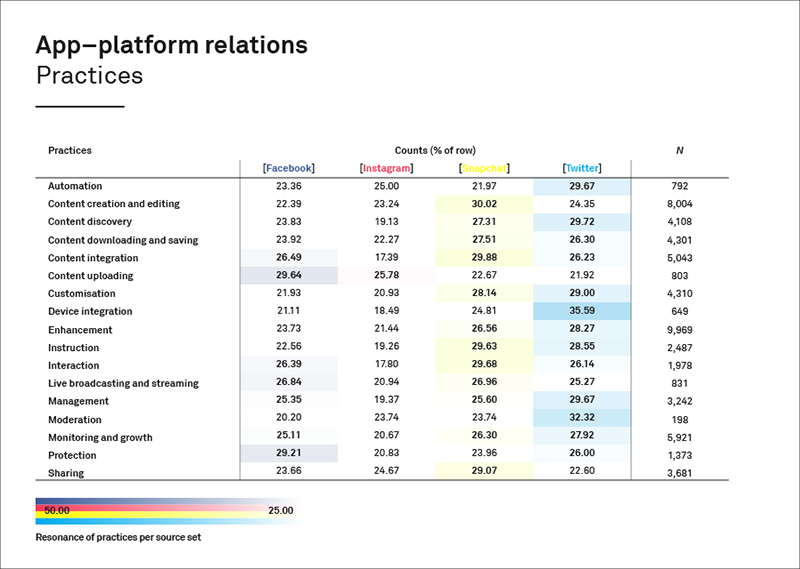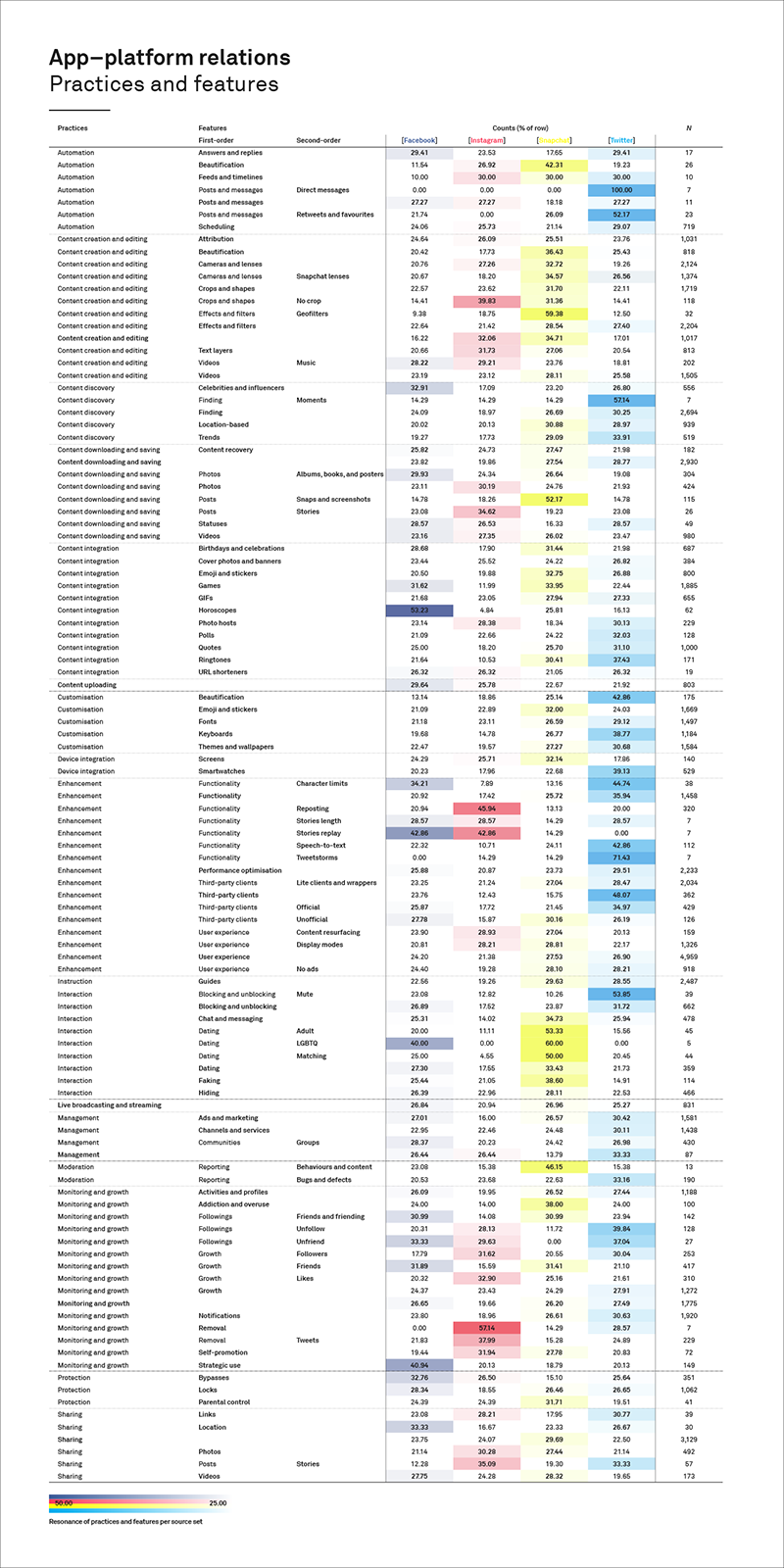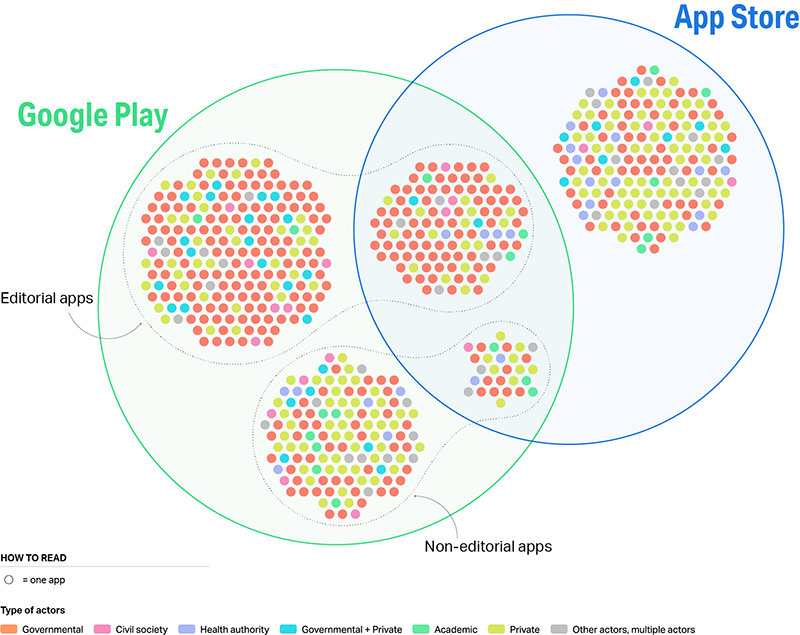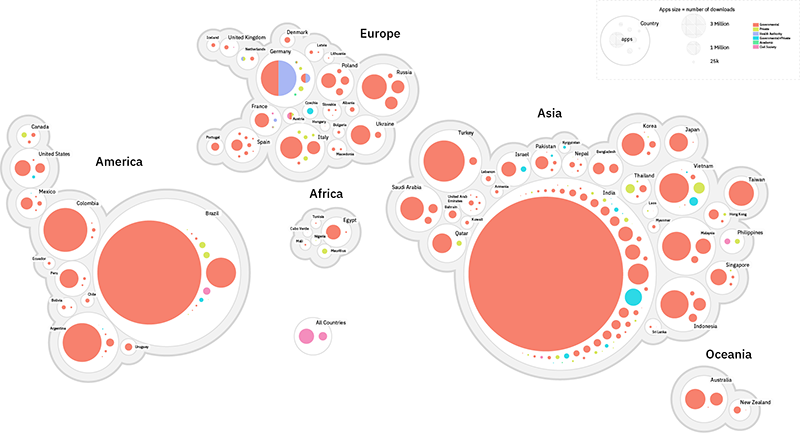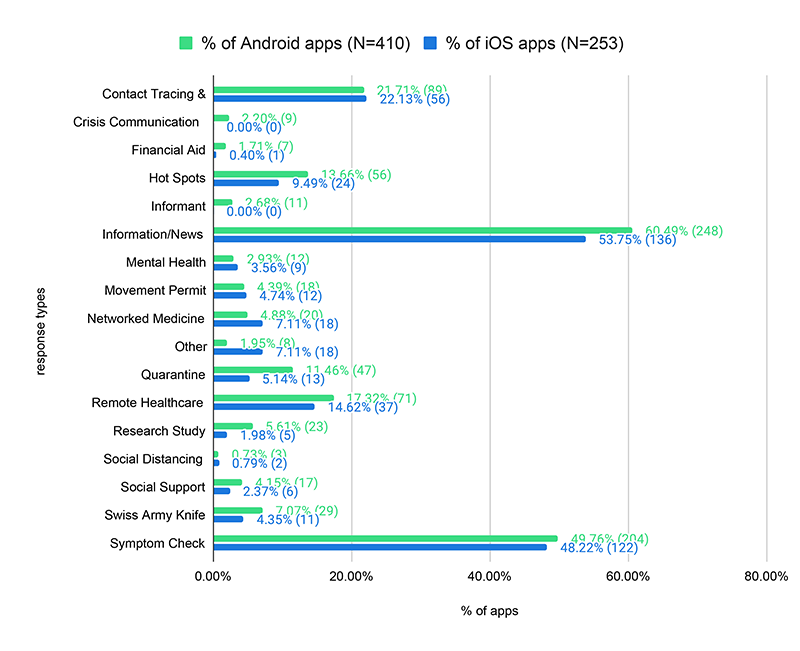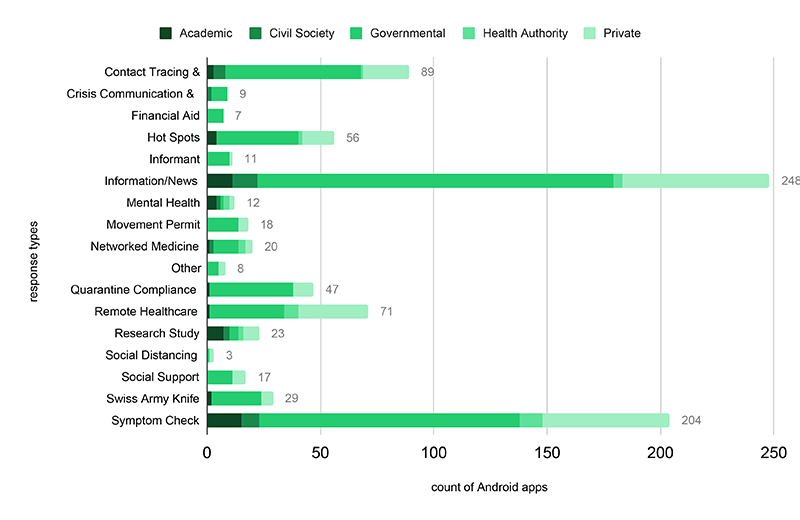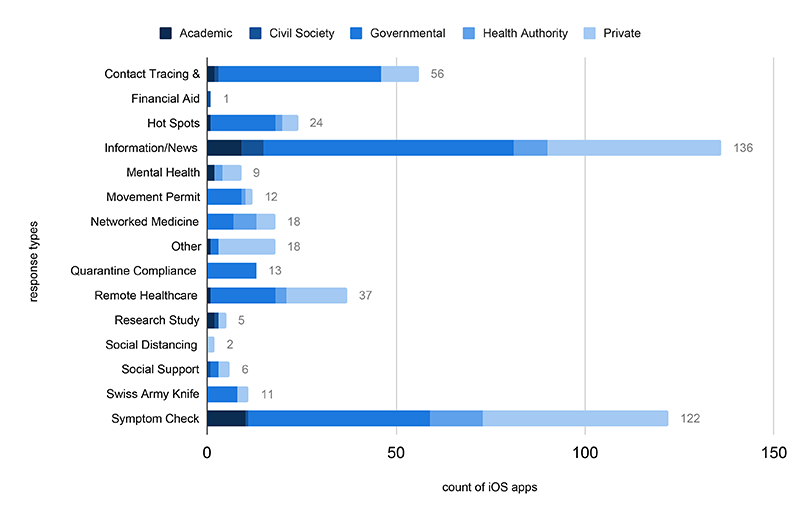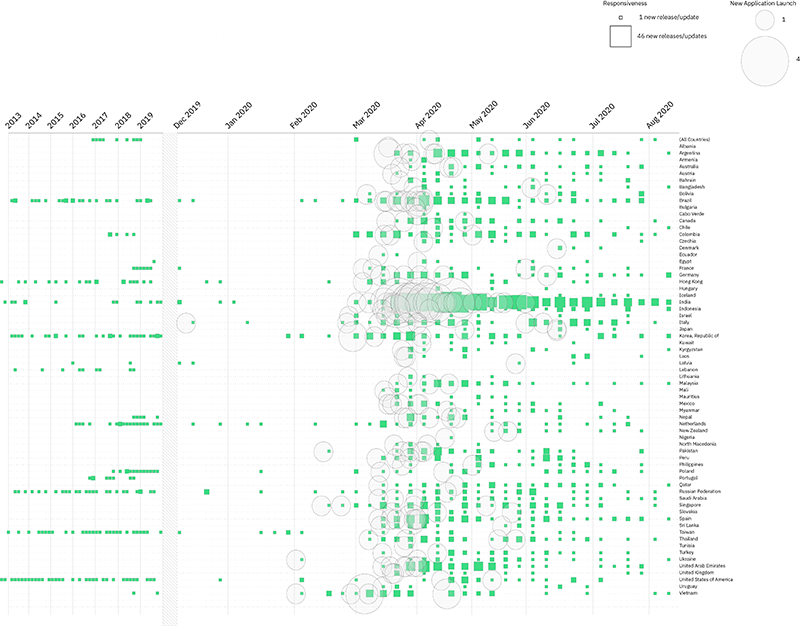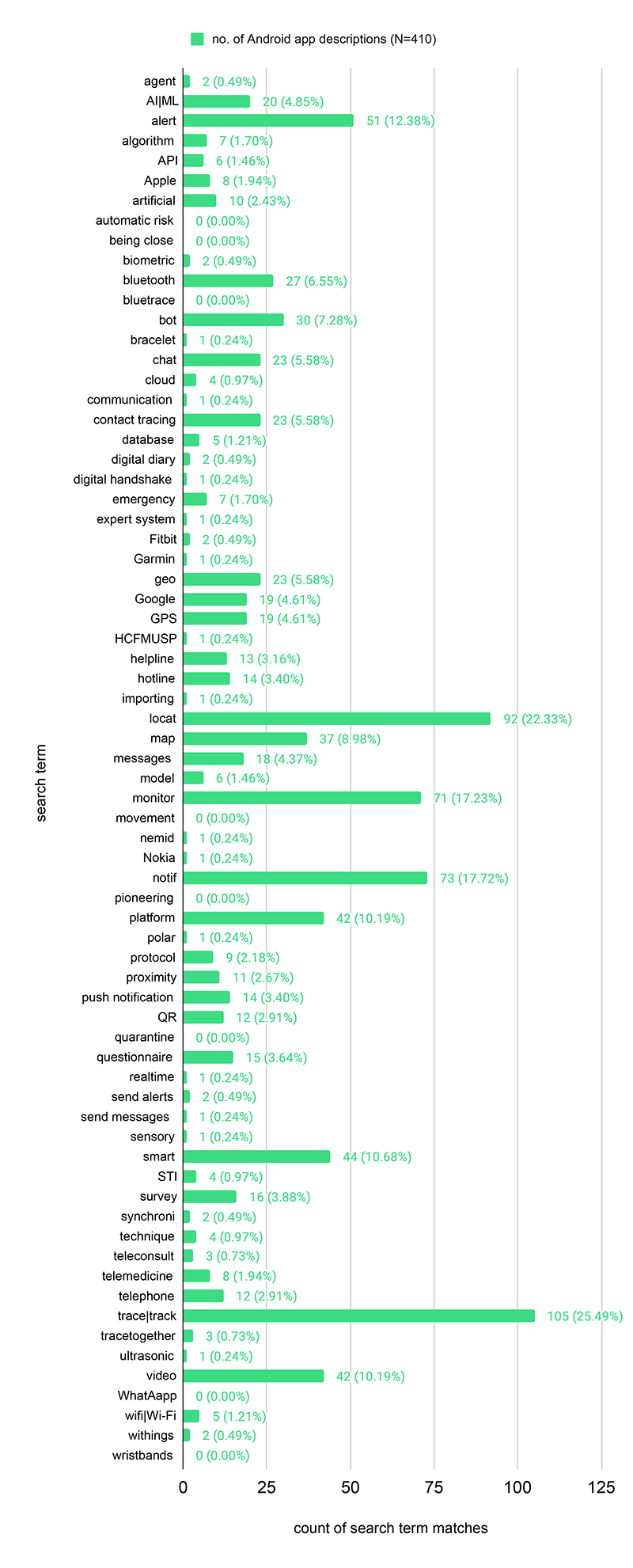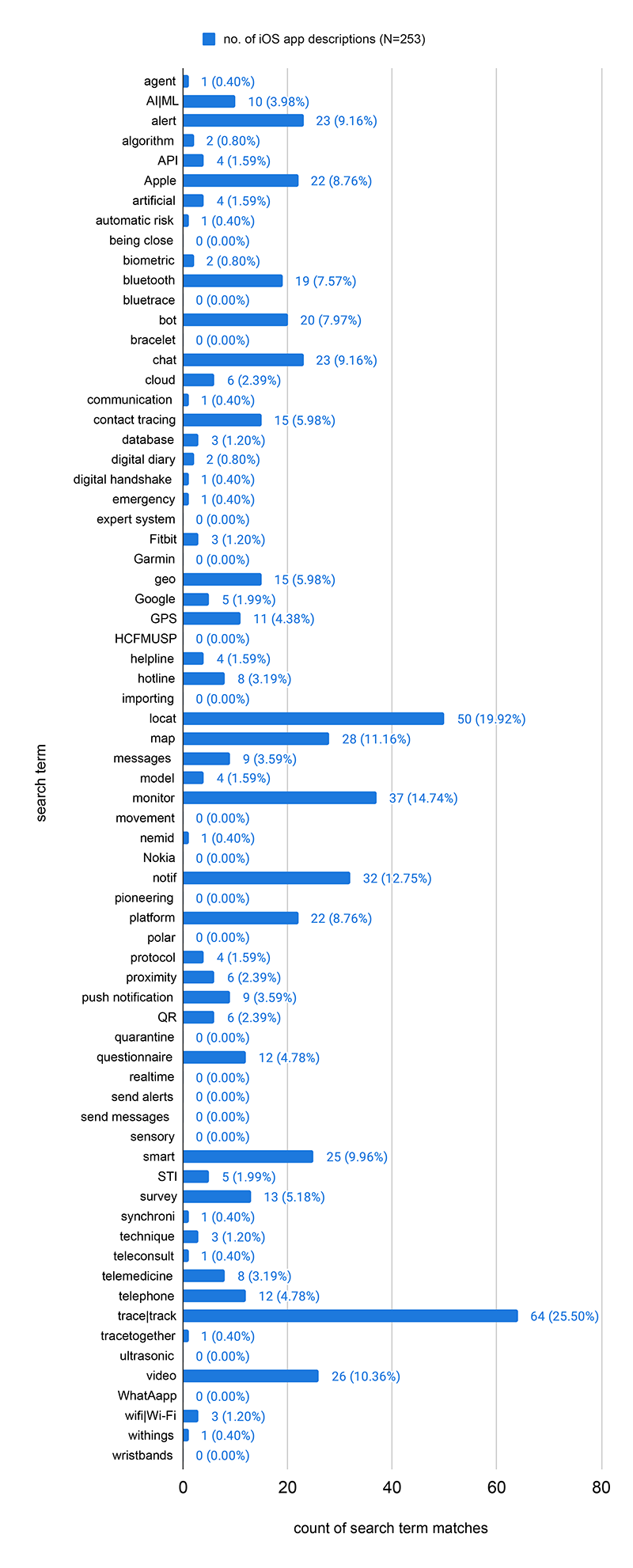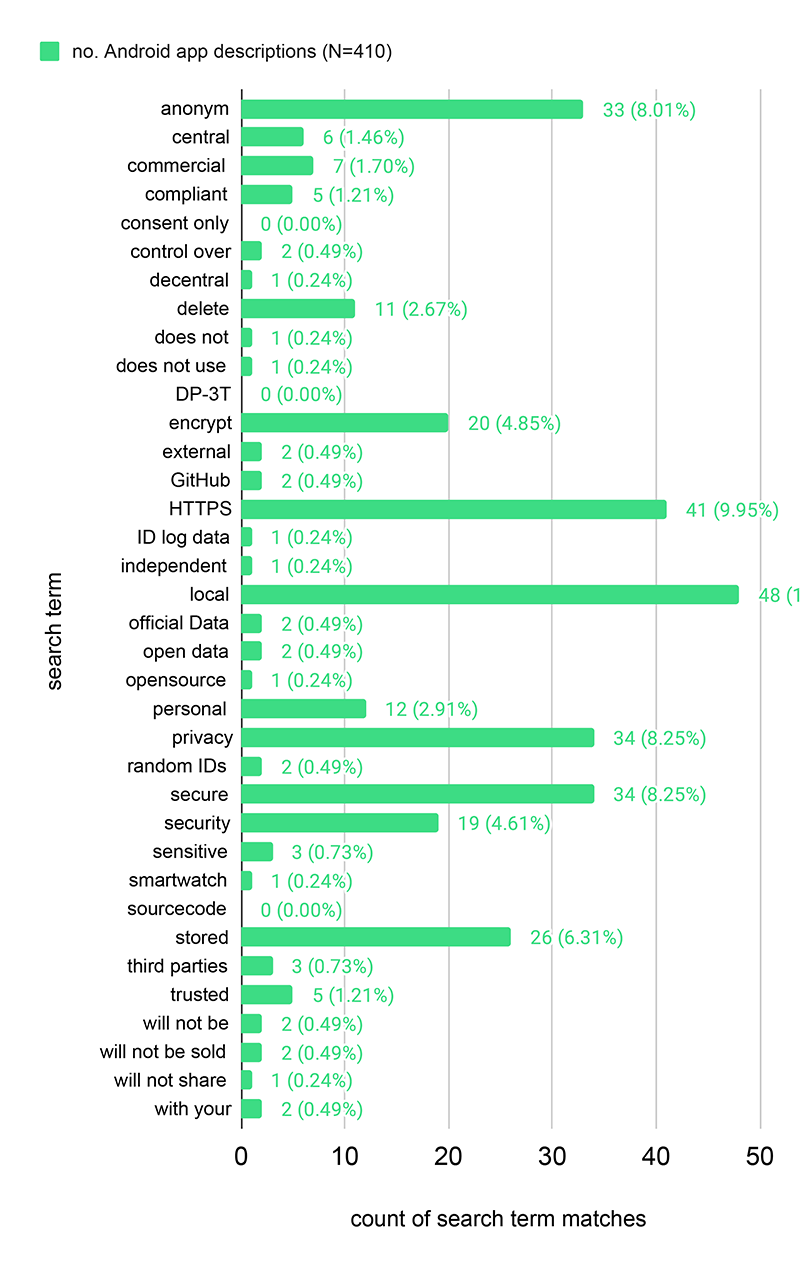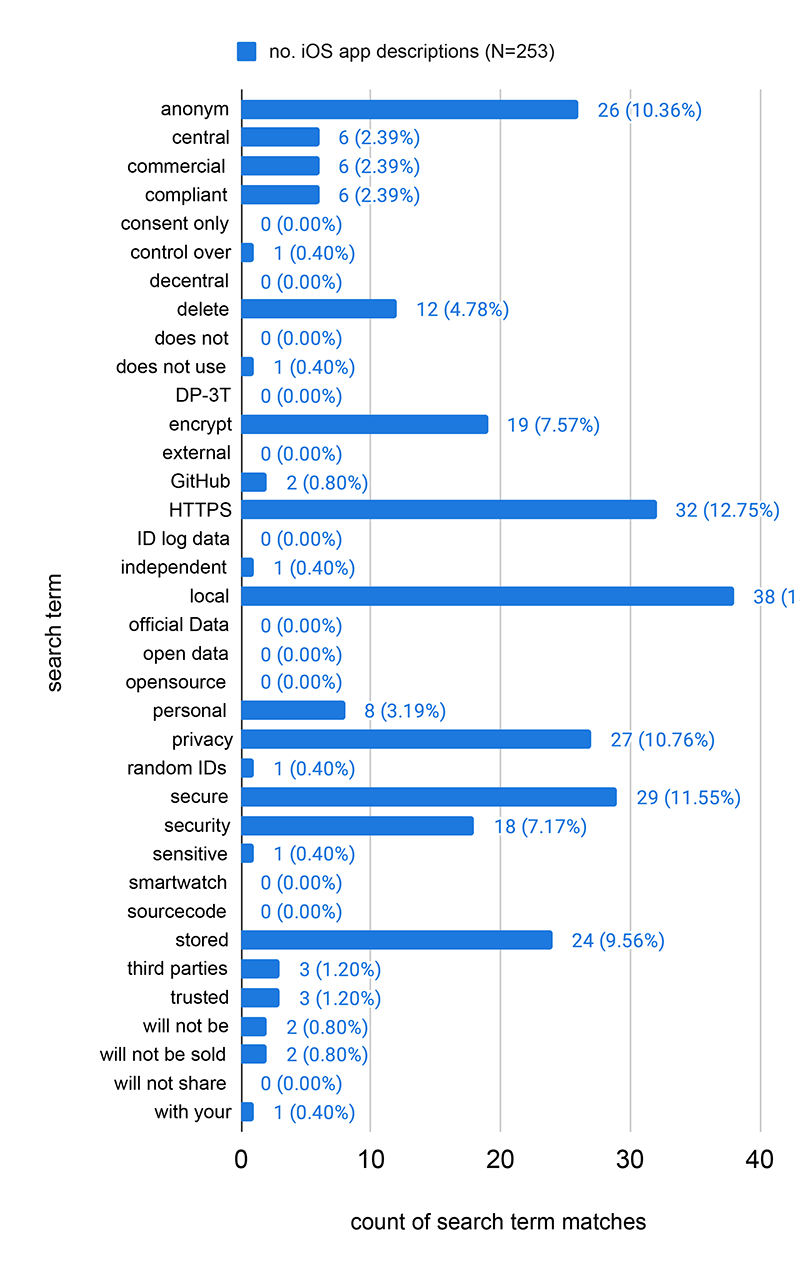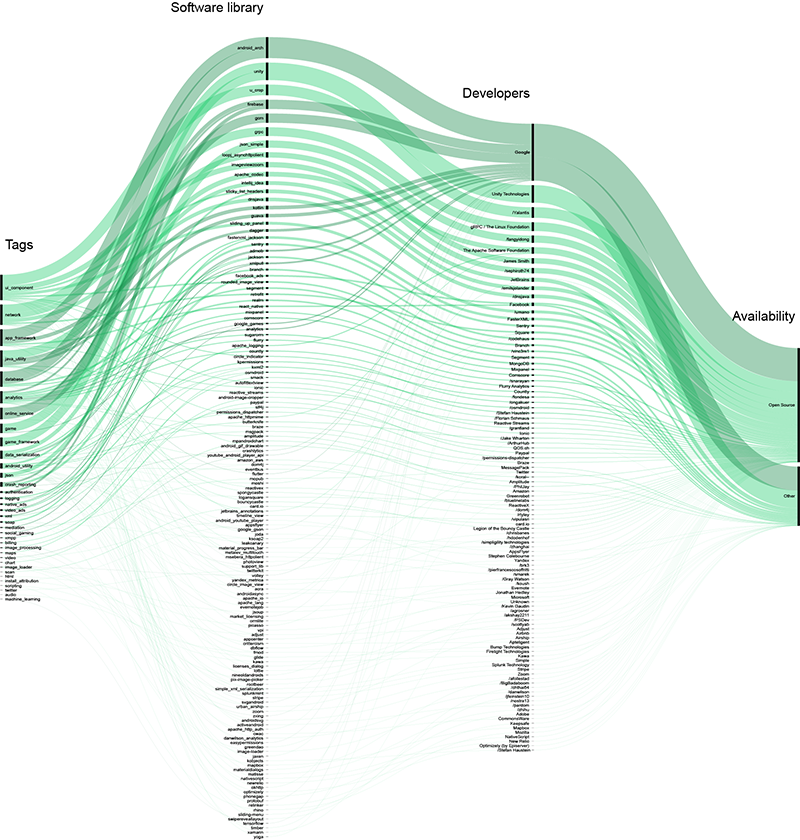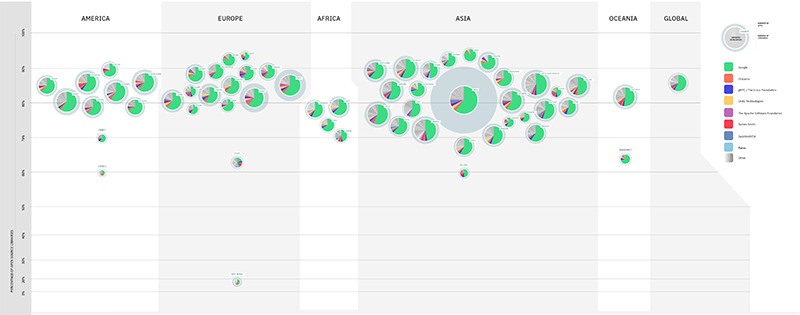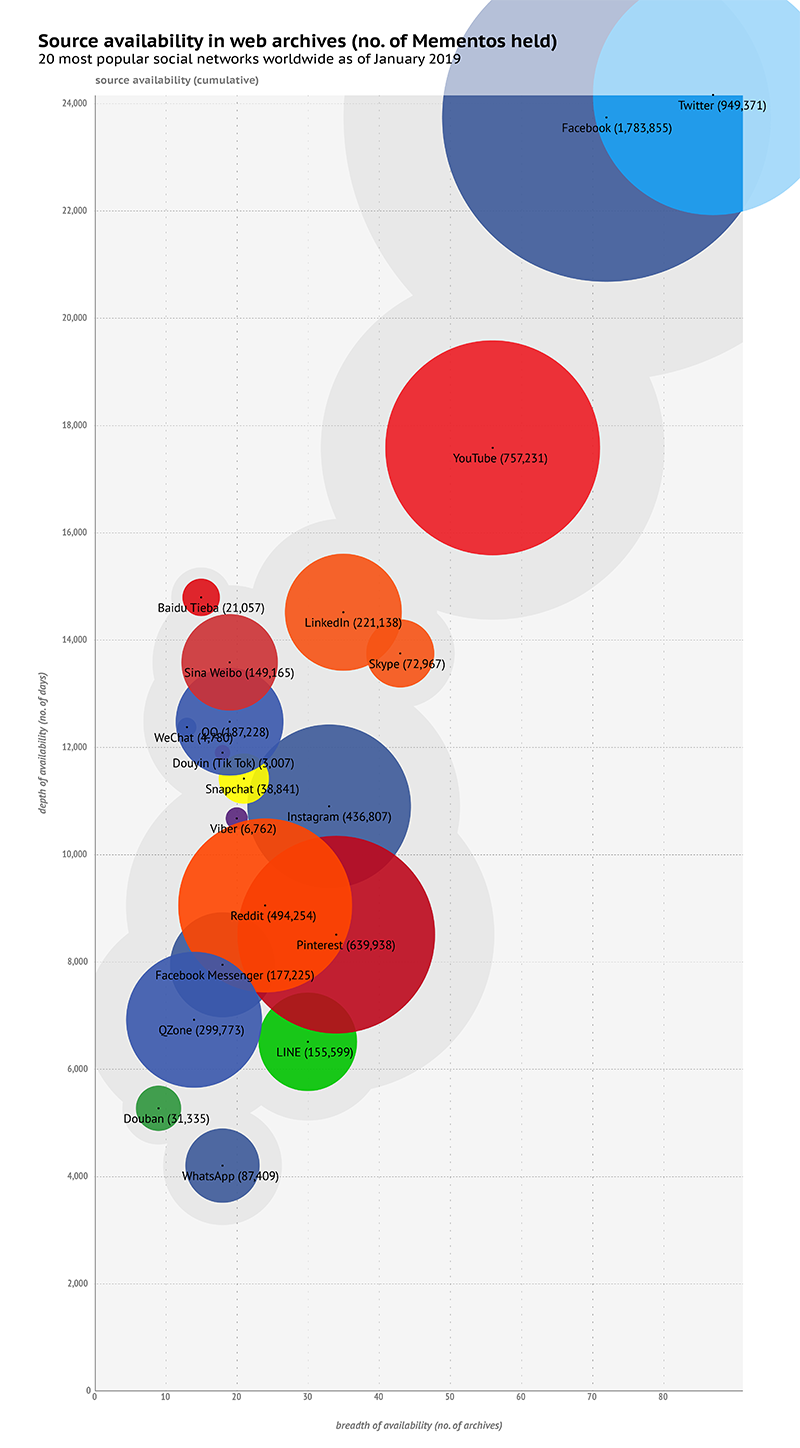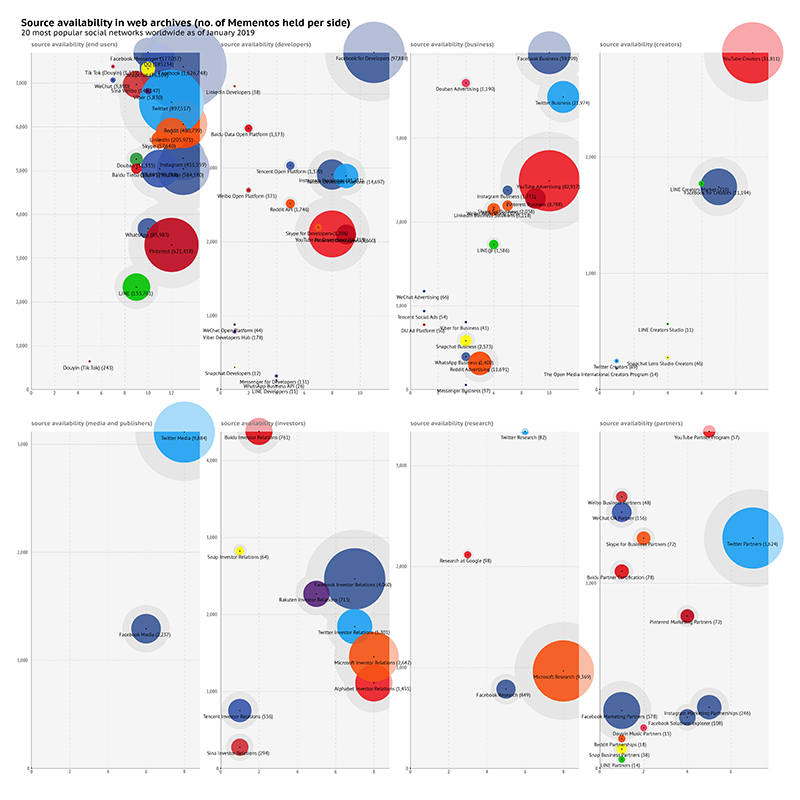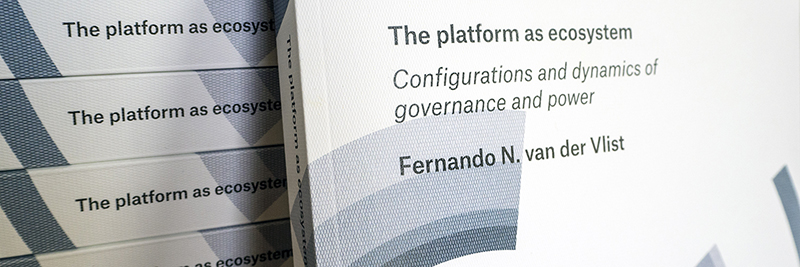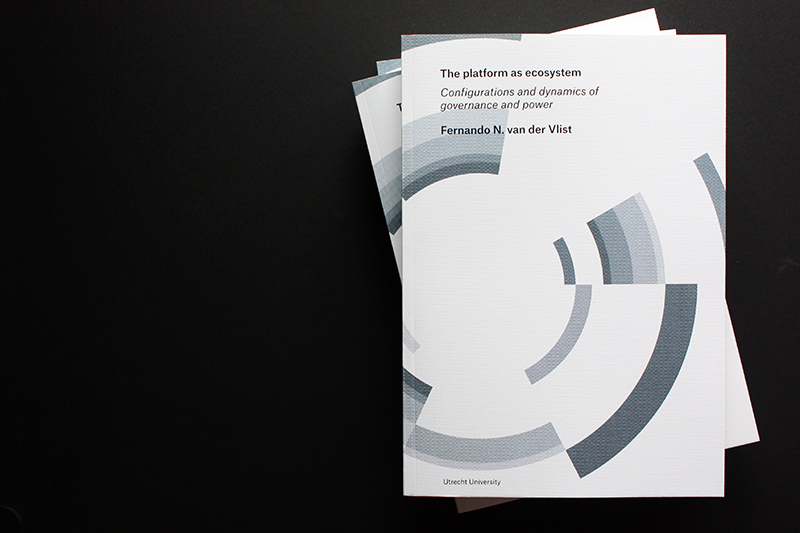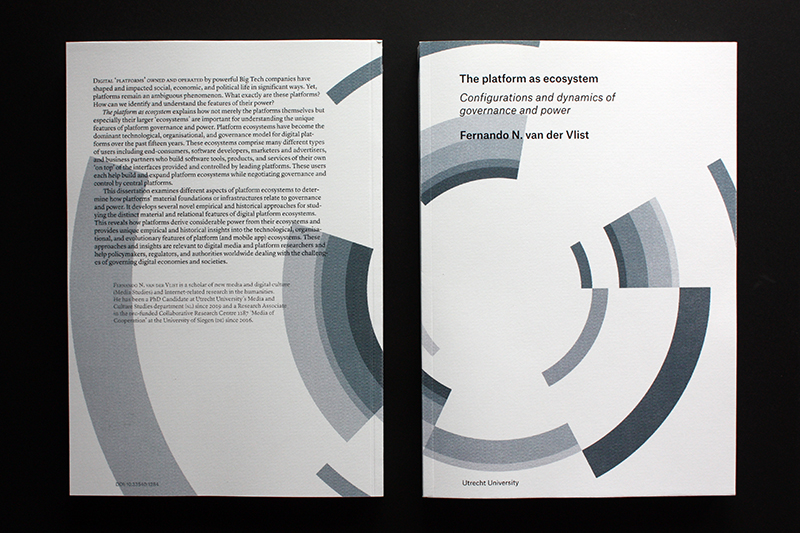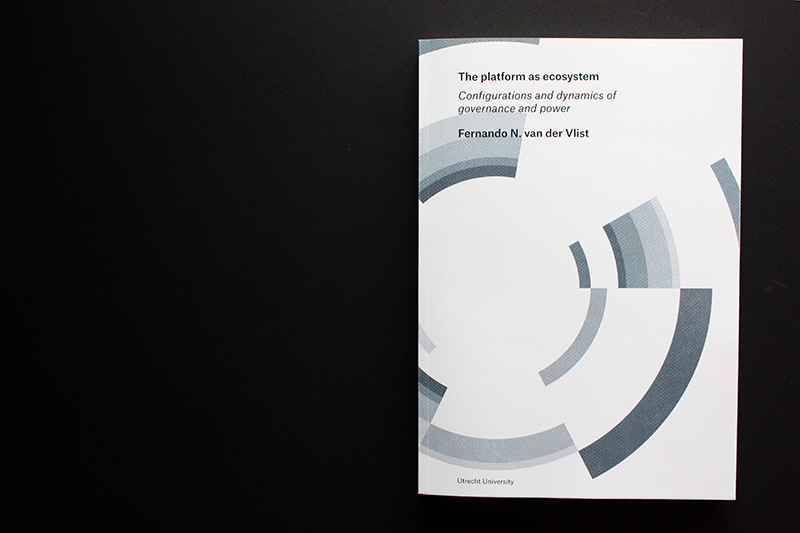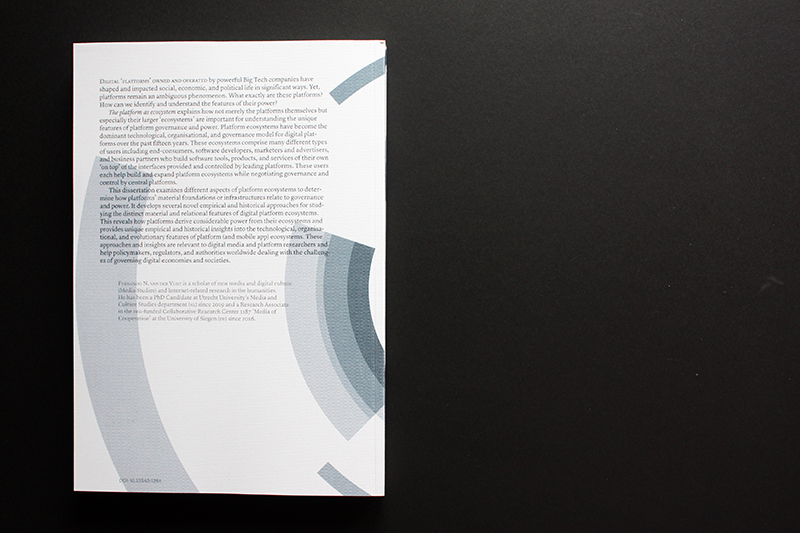Key Findings and Conclusions
- This dissertation offers an important empirical and methodological contribution to current research on the governance and power dynamics surrounding the digital ‘platforms’ owned and operated by Big Tech companies. It argues how not merely the platforms themselves but especially their larger ‘ecosystems’ are important for understanding the unique features of platform governance and power. Platform ecosystems have become the dominant technological, organisational, and governance model for digital platforms over the past fifteen years. It reveals how platforms derive considerable power from these ecosystems, which are understood and theorised as their spheres of influence.
- ‘Platforms’ engage in, and uphold, relationships with a variety of third parties, such as software and app developers, business partners, digital marketers and advertisers, and other types of users and developers. These different types of users help determine and shape what the platform is and becomes through their collective development work (‘innovation’).
- Chapter 2 shows that so-called application programming interfaces [APIs] (which software developers use to build applications or services ‘on top’ of platforms) are essential for understanding how platform governance and power dynamics are manifested within platform ecosystems. Indeed, these APIs form the material foundations of platform ecosystems and are important mechanisms through which platforms can exercise ‘infrastructural power’
- The role of technological integrations and business partnerships have often been understudied in the academic literature and in the context of regulation. However, Chapter 3 demonstrates that these aspects are critical to understanding how technological and organisational dependencies emerge in the platform ecosystem in the first place. Chapter 4 further argues based on a large-scale study that these technological and business integrations and partnership strategies are not only important, but essential to understanding how platforms gain strategic and infrastructural power from their position within the platform ecosystem.
- Chapter 5 shows that there are constant tensions between software developers who are building apps that do not always conform to the terms of services of these platforms, while the platforms try to maintain control over this development process for their own platform ecosystems. It shows how platforms deal with this tension and that not only platforms, but also app stores and software developers can influence the development of app ecosystems.
- Chapter 6 reveals the material conditions of platform governance and power in the larger app ecosystem based on a comprehensive large-scale analysis of apps developed worldwide in the context of the COVID-19 pandemic. Moreover, the study shows how Google and Apple as powerful ‘gatekeepers’ of the mobile platform and app ecosystem adapted and deployed their own governance during the crisis. The unprecedented nature of the crisis meant that both app stores employed more editorial interventions because of the high societal stakes. Such reconfigurations (about what is acceptable or not) may also have longer-term implications for the development of the global app ecosystem.
Belangrijkste resultaten en conclusies
- Dit proefschrift levert een belangrijke empirische en methodologische bijdrage aan actueel onderzoek naar governance en machtsdynamieken rondom de digitale ‘platforms’ van Big Tech bedrijven. Het beargumenteert dat niet alleen de platforms zelf, maar vooral hun grotere ‘ecosystemen’ belangrijk zijn om de unieke kenmerken van hun invloed en macht goed te begrijpen. Platform-ecosystemen zijn de afgelopen vijftien jaar het dominante technologische, organisationele en bestuurlijke model geworden voor digitale platforms. Hiermee ontlenen platforms een groot deel van hun macht aan deze ecosystemen die kunnen worden begrepen en bestudeerd als invloedssferen.
- Platforms gaan allerlei verbindingen aan met externe partijen, zoals software- en app ontwikkelaars, bedrijven, marketeers, adverteerders en andere soorten gebruikers. Deze verschillende soorten gebruikers van platforms zijn tevens mede-ontwikkelaars van platform-ecosystemen. Daarmee bepalen zij mede hoe een ecosysteem eruit ziet en zich verder ontwikkelt.
- Hoofdstuk 2 toont aan dat zogenaamde application programming interfaces [APIs] (die softwareontwikkelaars gebruiken om applicaties of diensten ‘bovenop’ platforms te bouwen) essentieel zijn om te begrijpen hoe platform-governance en machtsdynamieken zich manifesteren binnen platform-ecosystemen. Deze API’s vormen namelijk de materiële fundamenten van platform-ecosystemen en zijn ook belangrijke mechanismen waarmee platforms hun ‘infrastructurele macht’ kunnen uitoefenen.
- De rol van technologische integraties en zakelijke samenwerkingsverbanden blijft in de wetenschappelijke literatuur en in het kader van regulering vaak onderbelicht. Hoofdstuk 3 toont echter aan dat deze aspecten van cruciaal belang zijn om te begrijpen hoe technologische en organisationele afhankelijkheden in het platform-ecosysteem ontstaan. Hoofdstuk 4 bouwt hierop voort en laat aan de hand van een grootschalige studie analyse zien dat deze technologische en zakelijke integraties en partnership-strategieën niet alleen belangrijk, maar zelfs essentieel zijn om te begrijpen hoe platforms strategische en infrastructurele macht verwerven uit hun positie in het platform-ecosysteem.
- Hoofdstuk 5 laat zien dat er voortdurend spanningen zijn tussen softwareontwikkelaars die apps bouwen die niet altijd in overeenstemming zijn met de voorwaarden van deze platforms, terwijl platforms proberen controle te behouden voor hun eigen platform-ecosystemen. Het laat zien hoe platforms omgaan met dit spanningsveld en dat niet alleen zij, maar ook app stores en softwareontwikkelaars invloed kunnen uitoefenen op de ontwikkeling van app-ecosystemen.
- Hoofdstuk 6 brengt de materiële eigenschappen van platform governance en macht in het grotere app-ecosysteem aan het licht aan de hand van een een grootschalige analyse van de apps die wereldwijd werden ontwikkeld in het kader van de COVID-19 pandemie. Bovendien laat de studie zien hoe Google en Apple als machtige ‘poortwachters’ van het mobiele platform- en app-ecosysteem hun eigen governance hebben aangepast en ingezet tijdens het verloop van de crisis. De exceptionele aard van de crisis betekende dat beide app stores meer redactionele interventies hebben toegepast, omdat er maatschappelijk veel op het spel stond. Dergelijke verschuivingen (over wat acceptabel is of niet) kunnen ook op langere termijn gevolgen hebben voor de ontwikkeling van het mondiale app-ecosysteem.
Table of Contents
| the-platform-as-ecosystem.pdf#page=4 | Titelpagina | p. III | 📄Front Matter | 🌍Public |
| the-platform-as-ecosystem.pdf#page=6 | Table of Contents | pp. V–VI | 📄Front Matter | 🌍Public |
| the-platform-as-ecosystem.pdf#page=8 | Lists of Tables and Figures | pp. VII–X | 📄Front Matter | 🌍Public |
| the-platform-as-ecosystem.pdf#page=12 | Preface | pp. XI–XVIII | 📄Front Matter | 🌍Public |
| the-platform-as-ecosystem.pdf#page=20 | Acknowledgements | pp. XIX–XXII | 📄Front Matter | 🌍Public |
| the-platform-as-ecosystem.pdf#page=24 | [Chapter 1] Introduction: No Platform, Just Ecosystems |
pp. 23–58 | 📄Chapter | 🌍Public |
Part I: Platform Interfaces
| the-platform-as-ecosystem.pdf#page=62 |
[Chapter 2] The Technicity of Platform Governance: Evolving Facebook’s Application Programming Interfaces |
pp. 61–96 | 📄Chapter | 🌍Public |
Part II: Business Ecosystems
Part III: Mobile Ecosystems
| the-platform-as-ecosystem.pdf#page=248 | [Chapter 7] Conclusion: On the Ecosystems of Platforms |
pp. 247–264 | 📄Chapter | 🌍Public |
| the-platform-as-ecosystem.pdf#page=266 | Appendices | pp. 265–286 | 📄Back Matter | 🌍Public |
| the-platform-as-ecosystem.pdf#page=287 | Glossary of Abbreviations | pp. 287–290 | 📄Back Matter | 🌍Public |
| the-platform-as-ecosystem.pdf#page=292 ├ OSF DOI: 10.17605/osf.io/6cj5x |
Data Availability | pp. 291–292 | 📄Back Matter | 🌍Public |
| the-platform-as-ecosystem.pdf#page=294 | References | pp. 293–326 | 📄Back Matter | 🌍Public |
| the-platform-as-ecosystem.pdf#page=328
├ OSF DOI: 10.17605/osf.io/6cj5x ├ Linked to URL: zotero.org |
Further Resources | pp. 327–328 | 📄Back Matter | 🌍Public |
| the-platform-as-ecosystem.pdf#page=330 | Summary | pp. 329–332 | 📄Back Matter | 🌍Public |
| the-platform-as-ecosystem.pdf#page=334 | Nederlandse samenvatting | pp. 333–338 | 📄Back Matter | 🌍Public |
| the-platform-as-ecosystem.pdf#page=340 | Curriculum Vitæ | p. 339 | 📄Back Matter | 🌍Public |
Summary
This dissertation investigates the digital ‘platforms’ that form and shape our contemporary online media environment. It posits how not merely the platforms themselves but especially their larger ‘ecosystems’ are important for understanding the unique features of platform governance and power. Platform ecosystems have become the dominant technological, organisational, and governance model for digital platforms over the past fifteen years. It reveals how platforms derive considerable power from these ecosystems, which are understood and theorised as their spheres of influence. The main purpose of this research is to better understand how governance and power dynamics are manifested in the construction of platforms’ larger ecosystems.
To address this purpose, the dissertation develops a number of novel empirical and historical approaches for studying platform ecosystems that are based on the distinct materiality and relationality of digital ‘platforms’ as ecosystems. These approaches provide novel insights into the configurations and dynamics of platform governance and power in larger ecosystems.
The materiality of platforms consists of all kinds of traces and materials that have been left behind as part of their routine functioning, both as operational technologies and as (publicly-traded) companies. These include software tools and technical documentation for software developers, marketers, and advertisers, blog posts and help pages, terms and conditions for users and developers, and more. These materials provide unique research opportunities to surface the material and relational properties of digital platforms to better understand the larger power structures of platforms. This involves the use of so-called ‘platform boundary resources’, which are the software tools, materials, and regulations that enable third-parties to develop applications and services ‘on top’ of digital platforms. These resources facilitate third-party software development and thus contribute to innovation in the platform ecosystem. This dissertation uses these resources to surface and study the relations and material conditions of leading digital platforms, including Facebook (and Instagram), Twitter, Google, and Apple.
The relationality—or the relational construction—of platforms highlights the various relations that platforms engage in, and uphold, with a variety of third parties, such as software and app developers, business partners, digital marketers and advertisers, and other types of users and developers. That is, ‘platforms’ are adaptive to the needs of different types of users, who help determine and shape what the platform is and becomes through their collective development work (‘innovation’). It argues that because of these connections, platforms are always part of larger systems and structures, which digital media and platform scholars view and study as ‘ecosystems’. Platforms’ boundary resources provide unique opportunities to surface and study the technical and organisational relationships that platforms engage in. They offer important insights into how the relationships and interactions between platforms and other parties in the ecosystem are created, mediated, and governed by platforms. In addition, these materials help to understand how various third parties collectively contribute to the ongoing expansion of platform ecosystems, from which the ‘core’ platforms typically benefit the most. It is important to better understand these relationships and interactions between platforms and third parties, because they show that power dynamics are often complex and subtle, in part because these third parties help construct (and benefit from) the larger platform ecosystem.
Each chapter following the Introduction chapter presents a case study that makes a unique empirical, historical, and methodological contribution to surfacing, analysing, and visualising platforms’ unique position of power as part of larger ecosystems. Chapter 2 shows that so-called application programming interfaces [APIs] (which software developers use to build applications or services ‘on top’ of platforms) are essential for understanding how platform governance and power dynamics are manifested within platform ecosystems. Indeed, these APIs form the material foundations of platform ecosystems and are important mechanisms through which platforms can exercise ‘infrastructural power’. The chapter presents the results of a historical study of ‘Facebook’s Development Platform’ for building software applications, using historical Web sources on Facebook’s various APIs. These sources are used to examine the ‘technicity’—or the material-technological features— of platform governance. It shows how platforms design and use their APIs to shape and influence their relationships with third parties. At the same time, these APIs are also shaped and influenced by external pressures on the platform, such as social, competitive, and regulatory pressures to change.
The four subsequent case studies all focus on the larger ‘ecosystems’ of powerful (American) platforms and the business and mobile applications (‘apps’) built ‘on top’ of their material foundations (APIs) by different types of software developers. Chapter 3 builds on the previous chapter with a study of the co-evolution of Facebook’s platform architecture and the technological integrations and business partnerships that have enabled Facebook to become central to the larger platform ecosystem. This chapter also uses historical Web resources to reconstruct how Facebook’s boundaries have evolved (and expanded) by establishing technological and organisational relationships with third-party software developers, marketing and advertising developers, and business partners. These relationships can be understood as part of a broader strategy that has allowed Facebook to accelerate its entry into the digital marketing and advertising industry with the help of its business partners and through strategic acquisitions. The role of these technological integrations and business partnerships have often been understudied in the academic literature and in the context of regulation. However, this study demonstrates that these aspects are critical to understanding how technological and organisational dependencies emerge in the platform ecosystem in the first place.
Chapter 4 further argues that these technological and business integrations and partnership strategies are not only important, but essential to understanding how platforms gain strategic and infrastructural power from their position within the platform ecosystem. The chapter presents the results of a large-scale study of the partnerships and partner integrations of the twenty largest (most widely used) social media platforms. The study uses boundary resources to map the business ecosystem of these platforms and to expose the complex technological and organisational structures of the digital economy. Social media have a lot of power because of their unique position within this digital economy. The network analysis and visualisations provide important insights and ways into understanding the positions of platforms within their larger platform ecosystems and are essential for locating strategic and infrastructural (centralised) ‘nodes’ of power within them.
Chapter 5 explores the complex interactions that arise around the ‘programmability’ of social media and mobile platforms, or the extent to which third-party developers can influence platform development (and vice versa). This process is not only driven by platforms, but also to a significant extent by the influence of powerful app stores, such as Apple (App Store) and Google (Google Play). Moreover, the limits of this programmability are constantly being challenged by software developers. The chapter presents a detailed study of these dynamics as they play out in the app ecosystem around powerful (social media) platforms such as Facebook, Instagram, Snapchat, and Twitter. It shows that there are constant tensions between software developers who are building apps that do not always conform to the terms of services of these platforms, while the platforms try to maintain control over this development process for their own platform ecosystems. It shows how platforms deal with this tension and that not only platforms, but also app stores and software developers can influence the development of app ecosystems.
The last case study, Chapter 6, focuses on the role of Google and Apple as powerful ‘gatekeepers’ of the mobile platform and app ecosystem during the initial phase of the global pandemic caused by the coronavirus (COVID-19). During this crisis, app stores played a central role in mediating the response to the pandemic (in terms of apps) and the international relationships between governments, international (health) organisations, and civil society organisations. The study provides a comprehensive large-scale analysis of apps developed worldwide in the context of the pandemic response. This reveals a tension between different types of interests: on the one hand, the private and commercial interests of platform and app store owners, and on the other hand, the public interests of governments, civil society and health organisations, and citizens in countries and regions worldwide. The analysis thus reveals the material conditions of platform governance and power in the larger app ecosystem. Moreover, the study shows how Google and Apple adapted and deployed their own governance during the crisis. The unprecedented nature of the crisis meant that both app stores employed more editorial interventions because of the high societal stakes. Such reconfigurations (about what is acceptable or not) may also have longer-term implications for the development of the global app ecosystem.
The five case studies each make an original contribution to the interdisciplinary literature on Media Studies, especially on digital platforms and infrastructure (i.e., Platform Studies). They show how the material foundations or infrastructures of platform ecosystems relate to platform governance and power. Collectively, they provide important empirical and historical insights into the technological and structural characteristics, the organisational features, and the dynamics and evolutionary features of platform and app ecosystems. A better understanding of these characteristics is not only of interest to scholars but can also help policymakers and authorities worldwide regulate powerful Internet companies. In this regard, it is particularly important to consider the shift from individual ‘platforms’ to the ‘ecosystems’ of platforms, within which the power of platforms manifests.
Additionally, because these ecosystems are not visible by default, they always need to be located and made visible before they may be analysed, contextualised, critiqued, or regulated. The dissertation contributes novel approaches, empirical materials, and techniques to help articulate, visualise, and analyse the ecosystems of platforms in terms of their technological, organisational, and dynamics or evolutionary characteristics.
Nederlandse samenvatting
Dit proefschrift betreft de digitale platforms die onze hedendaagse online mediaomgeving vormen en vormgeven. Het beargumenteert dat niet alleen de platforms zelf, maar vooral hun grotere ‘ecosystemen’ belangrijk zijn om de unieke kenmerken van hun invloed en macht goed te begrijpen. Platform-ecosystemen zijn de afgelopen vijftien jaar het dominante technologische, organisationele en bestuurlijke model geworden voor digitale platforms. Hiermee ontlenen platforms een groot deel van hun macht aan deze ecosystemen die kunnen worden begrepen en bestudeerd als invloedssferen. Het belangrijkste doel van dit onderzoek is om beter te begrijpen hoe governance en machtsdynamieken zich manifesteren in de ontwikkeling van platform-ecosystemen.
Het proefschrift ontwikkelt een aantal nieuwe empirische en historische benaderingen voor het bestuderen van platform-ecosystemen die zijn gebaseerd op de bijzondere materiële en relationele eigenschappen van digitale ‘platforms’ als ecosystemen. Deze benaderingen geven zo inzicht in de configuraties en dynamieken van platform governance en macht binnen het grotere ecosysteem.
De materiële eigenschappen van platforms bestaan uit allerlei verschillende sporen en documenten die zijn achterlaten als onderdeel van hun reguliere functioneren, zowel als operationele technologieën en ook als (beursgenoteerde) bedrijven. Het gaat dan bijvoorbeeld om software-tools en technische documentatie voor softwareontwikkelaars of marketeers en adverteerders, blogs en help-pagina’s, de algemene voorwaarden voor gebruikers en ontwikkelaars, en meer. Deze materialen bieden unieke onderzoeksmogelijkheden om de materiële en relationele eigenschappen van digitale platforms bloot te leggen, en daarmee ook de grotere machtsstructuren van platforms beter te begrijpen. Hiervoor wordt ook gebruik gemaakt van zogenaamde ‘platform boundary resources’, oftewel de diverse software-tools, documenten en voorwaarden die diverse externe partijen gebruiken om applicaties en diensten ‘bovenop’ digitale platforms te ontwikkelen. Deze hulpmaterialen faciliteren de ontwikkeling van software door derden en dragen op die manier bij aan de innovatie van het platform-ecosysteem. In dit proefschrift worden deze bronnen gebruikt om de relaties van toonaangevende digitale platforms, waaronder Facebook (inclusief Instagram), Twitter, Google en Apple te onthullen en te bestuderen.
De relationele eigenschappen van platforms leggen juist de nadruk op de verschillende verbindingen die specifieke platforms aangaan met allerlei externe partijen, zoals software- en app ontwikkelaars, bedrijven, marketeers, adverteerders en andere soorten gebruikers. De verschillende soorten gebruikers van platforms bepalen als mede-ontwikkelaars mede hoe het systeem eruitziet en zich verder ontwikkelt. Vanwege deze verbindingen maken platforms altijd deel uit van grotere systemen en structuren die door digitale media- en platformwetenschappers worden gezien en bestudeerd als ‘ecosystemen’. Eerdergenoemde boundary resources bieden unieke mogelijkheden om de technische en organisationele relaties die platforms hebben te onthullen. Ze bieden belangrijke inzichten in hoe de verhoudingen en interacties tussen platforms en andere partijen in het ecosysteem door platforms tot stand komen, worden bemiddeld en vormgegeven. Daarnaast helpen deze materialen om te begrijpen hoe diverse externe partijen gezamenlijk bijdragen aan de steeds verdere uitbreiding van platform-ecosystemen, waarvan de centrale platforms zelf vaak het meeste profiteren. Het is belangrijk om de verhoudingen en interacties tussen deze verschillende partijen beter te begrijpen, omdat het laat zien dat machtsdynamieken vaak complex en subtiel zijn, onder meer doordat derden ook meebouwen (en profiteren) van het grotere platform-ecosysteem.
Elk hoofdstuk na de Introductie presenteert een deelstudie die een empirische, historische en methodologische bijdrage levert om de unieke machtspositie van platforms als integraal onderdeel van platform-ecosystemen te leren zien en begrijpen. Hoofdstuk 2 toont aan dat zogenaamde application programming interfaces [APIs] (die softwareontwikkelaars gebruiken om applicaties of diensten bovenop platforms te bouwen) essentieel zijn om te begrijpen hoe platform-governance en machtsdynamieken zich manifesteren binnen platform-ecosystemen. Deze API’s vormen namelijk de materiële fundamenten van platform-ecosystemen en zijn ook belangrijke mechanismen waarmee platforms hun ‘infrastructurele macht’ kunnen uitoefenen. Het hoofdstuk presenteert de uitkomsten van een historische studie naar de ontwikkeling van Facebooks ‘platform’ voor het bouwen van softwareapplicaties en maakt daarvoor gebruik van historische webbronnen over Facebooks diverse API’s. Met deze bronnen wordt de ‘technicity’, oftewel de materieel-technologische kenmerken, van platform-governance onderzocht. Het laat zien hoe platforms hun API’s ontwerpen en inzetten om hun relaties met diverse externe partijen te kunnen vormgeven en beïnvloeden. Tegelijkertijd worden deze API’s ook weer gevormd en beïnvloed door de externe druk die van buitenaf op het platform wordt uitgeoefend, bijvoorbeeld onder druk van gebruikers, concurrenten of regelgevende instanties.
De vier daaropvolgende deelstudies richten zich allemaal op de grotere ‘ecosystemen’ van machtige (Amerikaanse) platforms en de bedrijfsmatige en mobiele applicaties (‘apps’) die door verschillende soorten softwareontwikkelaars bovenop hun materiële fundamenten (API’s) zijn gebouwd. Hoofdstuk 3 bouwt voort op het vorige hoofdstuk met een studie naar de co-evolutie van Facebooks platform-architectuur en de technologische integraties en zakelijke samenwerkingsverbanden waarmee Facebook zich een centrale plek heeft kunnen verwerven in het grotere platform-ecosysteem. Ook dit hoofdstuk gebruikt historische webbronnen om te reconstrueren hoe Facebooks boundaries zich hebben ontwikkeld (vooral steeds verder hebben uitgebreid) door het aangaan van technologische en organisationele relaties met externe softwareontwikkelaars, marketing en advertentie ontwikkelaars en zakenpartners. Deze relaties kunnen ook worden begrepen als onderdeel van een bredere strategie waarmee Facebook met behulp van haar zakenpartners en door strategische overnames haar intrede in de digitale marketing- en advertentie-industrie heeft kunnen versnellen. De rol van deze technologische integraties en zakelijke samenwerkingsverbanden blijft in de wetenschappelijke literatuur en in het kader van regulering vaak onderbelicht. Deze studie toont echter aan dat deze aspecten van cruciaal belang zijn om te begrijpen hoe technologische en organisationele afhankelijkheden in het platform-ecosysteem in eerste plaats zijn ontstaan.
Hoofdstuk 4 bouwt hierop voort en laat zien dat deze technologische en zakelijke integraties en partnership-strategieën niet alleen belangrijk, maar zelfs essentieel zijn om te begrijpen hoe platforms strategische en infrastructurele macht verwerven uit hun positie in het platform-ecosysteem. Het hoofdstuk presenteert de uitkomsten van een grootschalige studie naar de partnerschappen en partner-integraties van de twintig grootste (meest gebruikte) sociale mediaplatforms. De studie maakt opnieuw gebruik van boundary resources, dit keer om het zakelijke ecosysteem van deze platforms in kaart te brengen en daarmee de complexe technologische en organisationele structuren van de digitale economie bloot te leggen. Sociale media hebben veel macht vanwege hun unieke positie binnen deze digitale-economie. De netwerkanalyse en visualisaties bieden daarom belangrijke inzichten en manieren om de posities van platforms in het grotere platform-ecosysteem te kunnen begrijpen en zijn ook noodzakelijk om strategische en infrastructurele (gecentraliseerde) machtsknooppunten in deze ecosystemen te lokaliseren.
Hoofdstuk 5 onderzoekt de complexe interacties die ontstaan rondom de ‘programmability’ van sociale media en mobiele platforms, oftewel de mate waarin externe ontwikkelaars invloed kunnen uitoefenen op de ontwikkeling van platforms (en vice versa). Dit proces wordt niet enkel gestuurd door platforms, maar ook in belangrijke mate door de invloed van machtige app stores, zoals die van Apple (App Store) en Google (Google Play). Bovendien worden de grenzen van deze programmeerbaarheid ook voortdurend door softwareontwikkelaars betwist. Het hoofdstuk presenteert een gedetailleerde studie van deze dynamieken, zoals die zich afspelen in de app-ecosystemen rondom machtige (sociale media)platforms zoals Facebook, Instagram, Snapchat en Twitter. Het laat zien dat er voortdurend spanningen zijn tussen softwareontwikkelaars die apps bouwen die niet altijd in overeenstemming zijn met de voorwaarden van deze platforms, terwijl platforms proberen controle te behouden voor hun eigen platform-ecosystemen. Het laat zien hoe platforms omgaan met dit spanningsveld en dat niet alleen zij, maar ook app stores en softwareontwikkelaars invloed kunnen uitoefenen op de ontwikkeling van app-ecosystemen.
De laatste deelstudie, Hoofdstuk 6, gaat over de rol van Google en Apple als machtige ‘poortwachters’ van het mobiele platform- en app-ecosysteem in de beginfase van de wereldwijde pandemie als gevolg van het coronavirus (COVID-19). Tijdens deze crisis vervulden app stores een centrale rol in het bemiddelen van de reactie op de pandemie (op het gebied van apps) en ook van de internationale verhoudingen tussen overheden, internationale (gezondheid)organisaties en maatschappelijke organisaties. De studie biedt een uitgebreide grootschalige analyse van de apps die wereldwijd werden ontwikkeld in het kader van de reactie op de pandemie. Aan de ene kant manifesteren zich hier de private en commerciële belangen van platform- en app store eigenaren en aan de andere kant de publieke belangen van overheden, maatschappelijke- en gezondheidsorganisaties en burgers in verschillende landen en gebieden over de hele wereld. De analyse brengt daarmee de materiële eigenschappen van platform governance en macht in het grotere app-ecosysteem aan het licht. Bovendien laat de studie zien hoe Google en Apple hun eigen governance hebben aangepast en ingezet tijdens het verloop van de crisis. De exceptionele aard van de crisis betekende dat beide app stores meer redactionele interventies hebben toegepast, omdat er maatschappelijk veel op het spel stond. Dergelijke verschuivingen (over wat acceptabel is of niet) kunnen ook op langere termijn gevolgen hebben voor de ontwikkeling van het mondiale app-ecosysteem.
De vijf deelonderzoeken leveren zo elk een originele bijdrage aan de interdisciplinaire literatuur over mediastudies en in het bijzonder over digitale platforms en infrastructuur, oftewel de platformwetenschap. Ze laten zien hoe de materiële fundamenten of infrastructuren van platform-ecosystemen zich verhouden tot platform-governance en macht. Ze leveren daarmee gezamenlijk belangrijke empirische en historische inzichten op over de technologische en structurele kenmerken, de organisationele kenmerken en de dynamiek en evolutionaire kenmerken van platform- en app-ecosystemen. Een beter begrip van deze kenmerken is niet alleen van belang voor wetenschappers, maar kan ook beleidsmakers en autoriteiten helpen bij het reguleren van machtige internetbedrijven. Hierbij is het met name van belang om stil te staan bij de verschuiving van individuele ‘platforms’ naar de ‘ecosystemen’ van platforms, waarbinnen de macht van platforms zich manifesteert.
Bovendien kunnen zulke platform-ecosystemen niet zomaar worden geobserveerd, maar moeten altijd eerst worden opgespoord en blootgelegd. Pas daarna kunnen platform-ecosystemen worden geanalyseerd, gecontextualiseerd, bekritiseerd of effectief worden gereguleerd. Het proefschrift draagt daarom nieuwe benaderingen, empirische bronmaterialen en onderzoeksmethoden bij waarmee de ecosystemen van platforms kunnen worden blootgelegd, gevisualiseerd en geanalyseerd. Het gaat dan in het bijzonder om de technologische, organisationele en dynamische of evolutionaire kenmerken.
